





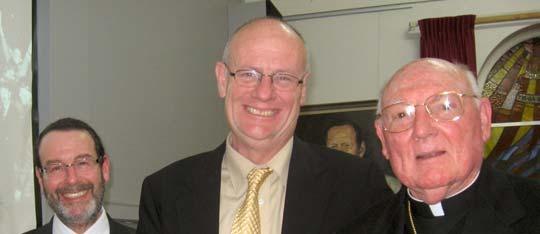

VOL. 29, No. 2 AUGUST/SEPTEMBER 2007 Registered by Australian Post, Publication No. VBH 7236 Registered Museum Under the Patronage of ìYad Vashemî Jerusalem 13-15 Selwyn Street, Elsternwick, Victoria 3185, Australia, Phone: (03) 9528 1985 Fax: (03) 9528 3758 Email: admin@jhc.org.au Website: http://www.jhc.org.au MESSAGE FROM STEVEN SPIELBERG RABBI, REVEREND AND CARDINAL IN CENTRE DISCUSSION RABBI, REVEREND AND CARDINAL IN CENTRE DISCUSSION REVEREND AND
The Jewish Holocaust Museum and Research Centre is an Institution dedicated to the memory of the six million Jews who were murdered by the Nazis and their collaborators between 1933 and 1945. We consider the finest memorial to all victims of racist policies to be an educational program which aims to combat anti-Semitism, racism and prejudice in the community and fosters understanding between people
Holocaust Centre Board
President: Pauline Rockman, Vice-President: Alex Dafner, Immediate Past President: Shmuel Rosenkranz, Chairman: Harry Bryce, Co-Treasurers: Elly Brooks, Secretary: Charles German, General: Allen Brostek, Abe Goldberg, Willy Lermer, Helen Mahemoff, Stan Marks, Adam Kreuzer, Eric Herz and Sophie Maj.
Foundation Patrons
Sir William Deane, Sir Gustav Nossal, Steven Spielberg, Professor Yehuda Bauer, Mrs. Diane Shteinman AM, Mr. Marc Besen AO, Mrs. Eva Besen.
Centre News
Editor: Stan Marks; Editorial Assistance: Shmuel Rosenkranz, Eva Marks & Lena Fiszman; Yiddish: Moshe
HOLOCAUST CENTRE AIMS
Stan Marks
What should a Holocaust Centre and its contents look like, represent and, above all, be its message left in a personís mind? One that is especially pertinent for these uncertain times.
I have been thinking a great deal about this following a visit to overseas Holocaust centres, seeing endless art works depicting the Holocaust and hearing about more Holocaust centres being set up around the world. The Los Angeles City Council, according to the JTS news gathering organisation, has approved a plot of land as the permanent home of the Holocaust. A proposed multi-million-dollar building is expected to be opened within a few years. It is planned to be mainly underground, nearby the current Martyrsí Monument. And New Zealand has opened a Holocaust Centre, based in the Beth El Wellington Community Centre, to record testimonies of New Zealand Nazi death camp survivors who have settled in Wellington. A Holocaust museum was also recently opened at the site of the Flossenberg concentration camp, in the southern German state of Bavaria, where approximately 30,000 victims perished.
The aims of these new centres, and others being planned, are to educate students in particular and the public generally in the importance of the Holocaust in todayís world, as a pivotal basis, a home for studying all aspects of understanding each other and living and working together perhaps one world or none. The keynote is education in all its forms and using all the latest scientific and technological advances and arts and crafts in communications and into every section of the community. The importance and power of a Holocaust museum is found in its authority, in presenting the facts as they happened. The Holocaust tells its own story and continues to combat the deniers and anti-Semitism.
The Melbourne Holocaust Centre is planning to upgrade its museum. Of course, its vision as written at the top of this page, will not change, but 21st century methods, especially of communication, will be used widely. The aims of the founders in 1984 remain, including that it stays as a memorial to a vibrant Jewish world that perished. The Holocaust Centre, as do other similar centres and artists of all kinds, can show very clearly that Jewish life has continued and enriched many nations and avenues of life.
The results achieved by the Melbourne Centre since 1984 have proven the foundersí ideas and wishes were certainly not a dream and should be maintained today. Just show and tell the truth about what happened.
MAKE A PLEDGE TO THE CENTRE
You can donate by filling out the pledge form on Page 28 of this Centre News, or call the Centre on 9258 1985 or the Foundation on 9822 8080.
2
Ajzenbud. CONTENTS Message from Minister Alexander Downer 3 Centreís New Board 3 Message from Shmuel Rosenkranz 4 Visitors to the Centre 4 New Staff and Executive Director 5 Friends Awards 6 Surviving the Post-Holocaust in Israel 6 Holocaust Memorials in Israel 8 State Governor visits the Centre 9 Dunera Boy Nuremberg Interpreter 10 A Library of Memories 11 Literature and the Holocaust 12 Privileges We Must Never Squander 14 USC University Testimonies Launch 16 Steven Spielbergís Message 16 Doug Greenberg at the Centre 17 Maly Kohn Professional Development Fund 17 Best Selling Authors at the Centre 17 Round the Departments 19 Vilna Today and the Holocaust 21 International Tracing Service 23 Volunteers Annual Awards 24 A Forgotten Hero 25 Holocaust and Christian / Jewish Theology 26 Donít Hide the Holocaust 26 Letters from Visitors 27 Make a Pledge 28 Archivesí Acquisitions 29 Personal Announcements & Future Events 30 Become a Friend of the Holocaust Centre 31 Yiddish Cover: Rabbi Fred Morgan, Reverend Tim Costello and Cardinal Idris Cassidy at the Centre. Steven Spielberg. Thomas Keneally at Centre 22
SURVIVORS ENRICH AUSTRALIAN LIFE Foreign Minister Alexander Downer

During my recent visit to Israel (26-27 June 2007), my third as Australiaís Minister for Foreign Affairs, I visited Yad Vashem and toured the new section. This was a deeply poignant experience.
I speak on behalf of the Government and the people of Australia in recognising the enormous significance of Yad Vashem to Israel, to Jewish people around the world and, indeed, to all of us, wherever we come from.
The museum is a testament to the millions of men, women and children who lost their lives in the Holocaust and a solemn reminder of the devastating consequences of anti-Semitism, racial hatred and persecution.
Yad Vashem will serve to remind future generations of the tremendous hope and power of the human spirit.
Australians of all backgrounds know this legacy well. After the Second World War, about 30,000 Holocaust survivors came to Australia. Starting new lives based on the freedom, tolerance and democracy, which are cornerstones of Australian life, survivors and their families have been able to preserve their values and traditions. Australian society is so much richer and stronger for the significant contributions that survivors and their descendants have made, not least in the professions, the arts, business and politics.
The Australian Government, both nationally and internationally has been active in promoting interfaith dialogue as a means towards meeting the increasing challenge of religious intolerance and extremism. In particular, Australia participates in the Holocaust Taskforce which urges states to develop educational programs, that builds on the message of Yad Vashem, which aims to inculcate future generations with the lessons of the Holocaust.

Yad Vashem is a place of deep sadness, but it is also a place of bright hope. Among the generations to come I hope it will serve to educate against ignorance and ensure the events of the Holocaust are never forgotten.
CENTREíS NEW BOARD
The Holocaust Centre is now run by a Board, and no longer a separate Board and Executive.

Pauline Rockman, with whom Shmuel Rosenkranz headed the centre in 2006-07, assumes the presidency of the centre. Last month, the centre announced the appointment of Bernard Korbman as executive director, a post he had served in a temporary capacity for more
than 18 months. Office-bearers and others elected at the AGM were Alex Dafner (vice-president), Charles German (honorary secretary), Elly Brooks (honorary treasurer), Harry Bryce (chairman), Eric Herz (finance), Abe Goldberg, Willie Lermer, Helen Mahemoff, Adam Kreuzer, Allen Brostek, Sophie Maj, Peter Gaspar and Stan Marks.

3
Standing: Harry Bryce, Eric Herz, Willy Lermer, Charles German, Adam Kreuzer, Elly Brooks, Bernard Korbman, Alex Dafner, Helen Mahemoff and Peter Gaspar. Seated: Pauline Rockman, Shmuel Rosenkranz and Abe Goldberg. Not in the photo: Allen Brostek & Stan Marks.
DONíT BE AFRAID OF THE FUTURE
Shmuel Rosenkranz has stepped down as past president and co-president of the Holocaust Centre to become Immediate Past President. Pauline Rockman, formerly co-president, is the new president.
In a special Centre News message, Mr. Rosenkranz said that when he became joint president of the Centre, with the late Bono Weiner, and then president, his vision was to extend the organisationís image in the Jewish community.


ìI believed our image was better known in the nonJewish community, because of the thousands of students who visit it, and the excellent amount of publicity we have had in the general media, as well as the Jewish press, over many years, including through our Centre News. It has been outstanding in every way.î he added.
ìI do believe my wishes are taking shape, in the sense that our Centre is now even more recognised at home and abroad. It is a world Centre and really on the international map. Travel almost anywhere in the world and they have heard of the Melbourne Holocaust Centre. A group of eight Asian students and teachers recently spent a day at the Centre because they had been told in New York when they said they were coming to Melbourne ñ Donít miss the Melbourne Holocaust Centre. It is an experience well worth having.î
He insisted the Centre was known not only for its widespread and much-praised educational policy over many, many years, but also because of what it stood for in regard to human rights, the dignity of all men, women and children. Humanity.
OVER 450,000 STUDENTS
ìJust imagine. Since 1984 over 450,000 students from Victorian High schools have each spent over two hours at the Centre, not only gaining a special insight into the Holocaust but also in combating racism, hatred and prejudice and fostering understanding. More than 22 years of passing on these vital messages. It is a special message, as many leading educators have said over numerous years.î
VISITORS TO THE CENTRE

ìI am very positive about the role a new generation is playing, and going to play, in keeping alive the message, indeed the messages, of the Centre,î he explained. ìI find this very heartening. The guides have a vital role in the running of this Centre, especially as the survivor guides (a centre backbone) have had since its inception in 1984. Their dedicated and committed roles must never be forgotten. But new guides and general volunteers are, and will be, taking over. It comes with the passing of time.î
Mr. Rosenkranz said he hoped these new Centre volunteers would carry on the traditions of the founders, the many educators who had determined and carried out the Centreís educational programmes and all who had been involved in its numerous activities since its foundation.
He insisted future guides should ensure they projected how the survivors had come to Australia with little money, little English but had one major featurehope. And they soon established new lives for themselves, contributed in many ways to the growth of the Australian community as a whole. They worked and studied and became victors not victims in this new and hospitable land, and many are still doing so. A wonderful tribute to the human spirit.
To the young men and women who will run the Centre, Mr. Rosenkranz emphasised ìDonít at all be afraid of the future. Grab your opportunities, and lead in the very human fields that are so vital in these times.î
He said that there had been many highlights during his work at the Centre. The opening by the GovernorGeneral, Sir William Deane, of the new building; General Cosgroveís visit; the visit by many local and international academics and other identities who had put forward many necessary thoughts for these uncertain times; our roles with universities and the activities of various departments. So many achievements.
ìBut, we must never rest on our laurels. There are projects to be carried out and so many requirements in these days of competition for funds and in every aspect of life. To the young, I say the traditional greeting ëChazak Vemazí, be of good courage and strength. And, above all, remember my door is open, my phone and my time are always available to you.î
4
Guide Willie Lermer hosted a Centre session for Federal Police (Security) and Victorian Police Sgt. Justin Berriman.
Guide Halina Zylberman, who showed Australian Jewish News Editor, Ashley Browne, around the Centre.
STAFF APPOINTMENTS
BERNARD KORBMANóEXECUTIVE DIRECTOR
Bernard Korbman was announced as the new Executive Director at the Annual General Meeting. Bernard has been acting in the position for two years. The position of Education Officer, which he formerly held, will now be advertised.
FRANKIE PINCHóLIAISON/SPECIAL PROJECTS MANAGER
Initially, I came to JHC following the sale of the office supply and retail stationery business that I had owned and run for 10 years.
My personal history is one that was thankfully only marginally affected by the Holocaust - my family is made up of the Pinch, Lands, Rosenblatt, Fish and Zandle families that were part of the pre-Depression years and rich Yiddish culture of Melbourne and Sydney who arrived in Australia in the 1920s.
One late afternoon in May 2006, after the Museum had shut for the day, I knocked at the Centre's door and was met by a bearded rabbinical-looking man (now Executive Director, Bernard Korbman) who took my
volunteer application written on a scrap piece of paper and said that the Centre would welcome my help. By late July, I was working with the Administration team answering phones and learning the ropes.
My background included marketing, advertising and retail management. Together with the Director and all staff members, volunteers and heads of departments, I am active in co-ordinating, organising and managing JHC projects.
I am at the Centre four days a week. As the Centre continues its mission and enters a new and challenging phase, I am glad to be part of the team that will make it happen. I see the future as being an amazing time of essential growth, engagement and even further acceptance for which its founders aimed in the broader Australian community.
DEBRA STIEBELóDEVELOPMENT MANAGER


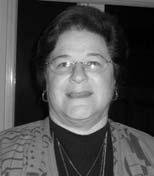

Melbourne-born Debra Stiebel has an Arts and Law degree. She lectured in Commercial Law for a number of years at the University of Melbourne and other tertiary institutions. She has worked as a vocational consultant, assisting young adults with closed head injuries. She also established a database of donors and fundraised for the Friends of the Hebrew University.
She believes the Centre has an important role to play in the community.
ROBYN FETTERóBOOKKEEPER
Sydney born, she has lived in NSW, SA and Victoria. Her father was in the automobile industry and regularly transferred. She insists that all this moving around helped her become a more outgoing person.
She is married to Ken Fetter. They have a son and married daughter. Robyn was for 10 years Centre Manager for the Balwyn Welfare Association ñ a Senior Citizens Day Activity Centre. This was a wonderful job with a lot of involvement with older people.
5
FRIENDS SCHOLARSHIP AND GRANT

The annual Friends of the Holocaust Meyer Burston Scholarship has been awarded to documentary and film producer Sean Meltzer and also a grant awarded to Dr. Julie Fenwick.
Sean received the award for his contribution to Holocaust education. He is involved in establishing a video library at the Centre. He has produced four March of the Living films and also filmed other Eastern European areas pertinent to the Holocaust. Dr Fenwick, who has worked at the Centre for some time, received her grant to examine the Centre's collection relating to ghettoisation and Jewish resistance.
Friends of the Holocaust Centre provide membership, social and fundraising activities to support the Centre's on-going needs in diverse areas. It also works with the Young Friends organisation and the 3rd generation, ensuring the continued success of the Centre and its ongoing vital message in these uncertain times. It also provides funds for various development

programs.
By joining the Friends you will give vital support and be able to participate part in the Centre's many activities. Foundation members' membership is valid until July 2008.
*****
The Friends committee comprises: Lulek Bron, Caroline Bryce (Secretary), Adam Kreutzer (Vice President) Silvana Layton, Sue Lewis (Co-Treasurer), Rosi Meltzer (Co-Treasurer), Annette Hayman, Anita Frayman, Susan Onas, Elly Brooks (President) and absent is Robyn Davis, Jessica Goldstein and Anita Bartfeld.
Thank you and I hope to see you all at our next function on 19th August. I will send the flyer on another email so you can send it on to your friends. Our mailout is finished so hopefully we will have a good response to our membership drive and raffle tickets. Regards, Elly.
Further details: Elly Brooks, 95969737.
SURVIVING POST-HOLOCAUST IN ISRAEL

Dr.
Natan Kellerman
At the age of 82, Sara is sitting next to the window in her small apartment in the town of Sderot in southern Israel, looking at the passersby running for shelter when the ëRed Alertí warning is heard.
She holds her breath waiting for the Qassam-rocket to fall, and then she relaxes as it explodes in the distance. It makes her remember the bombardment of 2nd World War when she was a child in Europe, before she was transported to Auschwitz and later to Bergen Belsen. ìNot much has changedî, she says with a trembling voice. ìMy entire life has been a long struggle for survivalÖî
Sara is visited by Mili, a social worker from Amcha ñ the Israeli psycho-social support center for Holocaust survivors and their families. ìItís a good feeling not to
be alone in these difficult times,î she says, ìand know that someone cares.î
She confirms what Eitinger (1993) stated many years ago: ìSurvivors are of course in need of help, for all their somatic ailments, but still more for their psychological isolation, their feeling of having lost their anchorage in the world and in humanity, their feeling that nobody cares if they are alive or not. If we manage to reverse this tragic evolution by establishing at least traces of real inter-human relationships and reduce the deep existential isolation, then we have made an important step, because it reduces the total sum of suffering in this world ó and this is ó so I believe ó the most important task and activity for all of us.î
More than 200 staff and 600 volunteers of Amcha are trying to do just that. Amcha is a non-profit organization dedicated to help survivors and their children to unburden their hearts through a variety of activities. Until its establishment 20 years ago, no other institution had dealt specifically with this subject or
6
Elly Brooks (Friends President) and Lyla Burston with Meyer Burston Scholarship winners: Julie Fenwick and Sean Meltzer.
Friends Committee
Dr. Natan Kellerman
exclusively with these clients.
Being aware of the survivorsí distrust of clinical psychiatry, Amcha provides non-material, psychosocial and preventive support, as well as mental health treatments from 12 centers all over Israel. The goal is to provide a framework for mutual aid, memory processing and grief resolution, as well as a place were Holocaust survivors and their families can feel understood. Most of the funding of Amcha comes from foreign subsidies and donations by friendsí groups abroad, including generous supporters from Australia.
0VER 200,000 SURVIVORS
Indeed, surviving the Holocaust in Israel is a completely different experience from surviving in Europe, the United States, or in Australia. For the more than 200,000 Holocaust survivors still living in Israel today, the past Holocaust trauma is triggered on an almost daily basis.
For them, the Holocaust has become a continual companion melody that defines every mood of their daily existence. For other citizens of Israel, however, it is felt only as an almost inaudible background noise that causes stress only in certain moments, such as when there is a national crisis. And while there may be a small minority of people who have grown up with a different narrative and cannot understand what the whole Holocaust fuss is all about, most informed Israelis today recognize the repeated and almost mythical characteristics of this historical echo.
In a country that has bombproof wastebaskets, it is always difficult to separate remnants of past Holocaust trauma from the present consequences of terrorism. The Intifada has caused Israelis to become agoraphobic, to be afraid of public spaces and of crowds. And to build a security wall which makes it feel like it is hiding in a large ghetto. The high percentage of recently bereaved; war widows, orphans, and invalids further aggravate this situation.
But there are chilling similarities between the scenes of the bombardments and terrorist attacks of today and the Holocaust events from the past. A mother sits with her daughter on her lap in a pizza restaurant in Jerusalem at the time of the explosion. She is found burned to death in this same position, which is a reminiscence of how her grandmother was found with her daughter in the gas chambers of Auschwitz some 60 years earlier. Children are killed in front of their mothers in kibbutz bedrooms, guests at a Passover celebration are suddenly blown to pieces, dancers at a wedding are murdered like in a pogrom, youth who travel by bus are suddenly mutilated, and so on.
How can Israelis be exposed to such events and not think of the Holocaust?
On a collective level, Israelis respond to its multiple
tragedies in two contrasting ways. On the one hand, the prior Holocaust trauma renders them more vulnerable to extreme stress. On the other hand, the successful coping of the initial Holocaust trauma has strengthened their resistance and made them more resilient to the effects of future trauma.
On the background of the Holocaust, there are a wide variety of emotional and cognitive responses to the present Intifada that range from catastrophic expectancy and fear to calculating defiance, outright paranoia and an urge to strike back. With a fearful undertone, some Israelis would say that ëwe should have learned by now not to trust our Gentile neighbor.í Others would rather take a dovish political stance, refusing to strike out at innocent victims, so as ënot to do to them, what the Nazis did to usÖî
POLITICAL PURPOSES


Any of these responses naturally mould the Israeli public into one or the other political bias and it is a main reason for the fact that the Holocaust has been and still is utilized for political purposes in every quarter of the political spectrum. It has been used both by hard-liners and doves to score political points and is often a reference point for cultural debates. In addition, the actual and imagined Holocaust narratives have influenced policy-making in the past and in the present.
According to writer Segev (1986), during its entire history, the Holocaust became a political football game in the hands of the various factions that fought for power in Israeli politics. Recently, for example, when gay marchers and Haredi (ultra-religious) protesters clashed in Jerusalem, they both utilized their ëlessonsí from the Holocaust to justify their point of view. The gay marchers called for more tolerance towards minorities ëafter all that we have been throughí, while the Haredi protesters stated that we should have learned, ëafter all that we have been through,í to keep our Jewish faith and tradition.
Finally, surviving Holocaust in Israel means also that we are constantly confronted with moral dilemmas. One of the most difficult recent ones is a situation that reminds us of the time when refugee Jews were unwelcome everywhere. What shall we do now when the survivors of Sudan and Darfur have entered Israel, wanting to receive asylum, to escape a certain death in their old countries?
Natan Kellermann, PhD is a clinical psychologist, formerly the executive director of Amcha. He will visit Melbourne in January 2008.
Anyone wishing to support Amchaís services for the homebound elderly Holocaust survivor population in Sderot, can contact the author at the following email address: natank@netmedia.net.il

CENTREíS OPENING HOURS
Monday, Wednesday: 10.00am ñ 4.00pm
Tuesday, Thursday, Friday: 10.00am ñ 2.00pm
Sunday: 12.00am ñ 4.00pm
Admittance free
7
HOLOCAUST MEMORIALS IN ISRAEL
Stan Marks
It's impossible when in Israel not to think about the Holocaust and, especially its educational importance, past, present and future. And how Holocaust centres, teachers and "experts" world-wide are using its key message, especially in these uncertain days. How are prejudice, hatred and injustice being combated and understanding fostered?
As I wandered through Israel, I was amazed at the nation's achievements, its eminence on the world stage in so many fields (especially scientific) and pondered the country's future. This was particularly pertinent as I visited Holocaust museums and monuments. These range from small monuments and artifacts to the amazing Yad Vashem, in line with the world's continuing interest in this pivotal era in Jewish history and of its lasting lessons for all peoples. Are its lessons being passed on so that especially young students will remember what they have seen, heard and generally experienced?
Set amid eye-catching Carmeil is the Holocaust Memorial Park. In simple but highly-arresting fashion sculptures depict artist Nicky Imber's ambition, after escaping from Dachau, to one day perpetuate the Holocaust in memory of all who died in the Shoah and knew their end would occur.
In 1978 his dream came true and Imber, a renowned international artist, created "From Holocaust to Resurrection" in the entrance to the northern city Carmiel. It is three distinct groupings: "Holocaust", "Wandering" and "Hope" (Resurrection).
governments around the world.
MEMORABLE YAD VASHEM
The new Holocaust History Museum at Yad Vashem, in Jerusalem, gives insights into the Holocaust from a Jewish perspective, with individual stories highlighted in an unfolding historical narrative. The story is told in chronolological order. As visitors walk they descend deep into the mountain, ascending towards the end, giving a breathtaking panoramic view of Jerusalem. To walk from Jewry almost destroyed in Europe to the modern State of Israel is quite an experience, one that lingers long. Unforgettable. The architecture of the museum is in itself something to behold, a prism-like triangle structure penetrating the mountain. A tour of the whole museum takes up over three hours, but one really needs to return again, to ponder, absorb it all and what it really tells us about our world. Yad Vashem is quite an inspiration for today's small planet, which in seems to have lost its way.
And to make our trip even more memorable, with touches of Australia, was our guide, vivacious Sydneysider Tamara Wassman, who also studied at Melbourne's Deakin and has visited the Melbourne Holocaust Centre many times. She has degrees in Cultural and Museum studies, and was very knowledgeable about all aspects of Yad Vashem.
Yad Vashem is situated on Har Hazikaron (the Mount of Remembrance), covers 45 acres and includes the world's most extensive Holocaust Library and Archive.
There are 16 chapters or exhibitions in the nine underground galleries. The personal names and details of millions of victims have been recorded on Pages of Testimony.
The first group comprises three sculptures, depicting life in the Ghetto. The second group, also of three sculptures, shows a family, a mother carrying her baby and her son grabbing her dress, the father carrying their very few belongings and the grandfather embracing a Torah, symbolizing the one last source of hope - faith in God.

The last group is a statue named Hope. This shows a woman proudly holding her new born child above her head, the initial Tzabar generation to rise in the Holy land. The resurrection of the Jewish people.
Nicky Imber (who died in 1996, aged 76) created paintings and busts for renowned identities and
Symbolic tombstones, filled out in memory of loved ones, and preserved in the Hall of Names. Yad Vashem wants more names before it is too late and asks anyone with information or wanting to know more about this sacred mission to visit the website www.yadvashem.org. Foreign Minister Downer's photo in the Hall of names was recently published in The Age. He said there were 10 places in the world people should visit and Jerusalem was one of them. (I received a very warm reaction during a breakfast meeting with Australia's Ambassador to Israel, James Larsen, who lives in Tel Aviv.)
I was particularly taken by the "Children's Memorial" hollowed out of an underground cavern. It is in memory of the estimated million and a half Jewish children who perished in the Holocaust. Standing listening to the names of each child, their ages and where they were born is an indescribable experience.
Other chapters include, The Warsaw Ghetto Square, Avenue of the Righteous Among the Nations, Hall of Remembrance, The Synagogue and the Visual Centre. In The Learning Centre computer stations provide access to a wide range of information from internationallyrecognized historians, philosophers and Yad Vashem's
8
Holocaust Sculpture
large knowledge base.

The new Holocaust Art Museum exhibits the world's largest collection of art fashioned in ghettos, camps, hideouts and diverse other areas, reflecting the spirit of the victims and survivors. It contains the world's first computerised archive and information area about Holocaust art and artists, an amazing archive of information. There are about 100,000 tiles and journals in many languages about Jewish life in Europe and its destruction. There are at least 55 million pages, including documents of Nazi bureaucrats and their counterparts throughout Europe, personal Jewish documents and legal documentation from proceedings against Nazi criminals and collaborators among many other features. An argosy of material.
When one looks at Yad Vashem, and other world Holocaust centres and areas, as in the UK and Europe (and Japan, too), we can be proud of our Melbourne Centre and what we have achieved with limited funds and the devotion over more than 20 years of committed volunteers. But, there is, no doubt, we can learn and gain from these large and small overseas Holocaust centres.
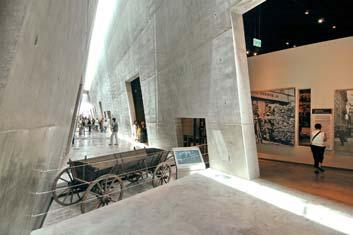
P.S.: I stood wondering whether Yad Vashem might be a special centre, place, to meet and discuss our old worldís preface ñ men and woman from all over the globe dedicated to somehow finding a peaceful way ahead. NaÔve? I know, it takes two to tango, but maybeÖ Yad Vashem did that to me.



CENTRE VISIT REMINDS STATE GOVERNOR OF INHUMANITY


ìMy visit to the Holocaust Centre was a frank reminder of the depths of manís inhumanity to man, said Professor David de Kretser, AC, Governor of Victoria, in a message to Centre News, following a visit to the Holocaust Centre.


Professor de Kretser spent two hours at the Centre, with his wife, meeting members of the Board, volunteers and staff. He saw over the permanent exhibition and also visited various departments, exchanging ideas and learning about the Centreís diverse activities.
As a school was at the Centre, he was able to gain an insight into what students experience during their visits and glean ideas of what young Australians feel about their visits and what it might mean for their futures and about understanding different races, religions and ways of life. Opening doors to understanding.
He heard about the thousands of Victorian high school students who have spent more than two hours at the Centre, since it opened in 1984, gaining an insight
not only into the Holocaust but its diverse activities in combating racism, hatred and prejudice and fostering understanding among all sections of the community.
In his special Centre News message Professor de Krestser said ìThe personal accounts of the tragedies put a very human face to the suffering and yet showed the incredible resilience of the human spirit.
ìOne could only be impressed by the willingness of the survivors to relive their personal experiences in the hope that such genocides might never occur again. May your work with our younger generations continue into the future to ensure that these events are not forgotten and that hate and intolerance cannot prevail.î
Shmuel Rosenkranz said the visit was a wonderful experience for all concerned. ìA special day to remember for many reasons. An incentive for those involved as volunteers and staff at the Centre to continue to explain the message of the Holocaust and its vital relevance in todayís uncertain world. A very special occasion for all Concerned.î
9
Yad Vashem: The Childrenís Memorial, Exterior of the new Museum, Inside the Museum.
Emma Fell (Aide), Willy Lermer, Masha Weiner & Governor David De Kretser.
Suzie Nozick with Governor David de Kretser and Mrs. Jan de Kretser.
DUNERA BOY NUREMBERG INTERPRETER
Stan Marks
The story of how a Dunera boy became, at age 22, Chief American interpreter at the WW11 Nuremberg War Crimes Trials, helped liberate Dachau and went on to great prominence in American life is a revealing story, especially in what these trials accomplished.
What legacy have the Nuremberg trials left and, above all, how did the Nazi murderers face the possibility of their being found guilty and executed?

Richard Sonnenfeldt ( in his fascinating book ìWitness To Nuremberg,î published by Arcade) tells how he dug deep into the minds of Streicher, Speer, Goring, von Ribbentrop and many concentration camp commanders to ascertain what motivated them to do what they did, and what were the real reasons for the Holocaust and organised murder of millions of people.
And it all came after he was taken from England aboard the Dunera (his Jewish parents were able to get him out of his native Germany, to England, aged 16), brought to Australia, as an enemy alien, aboard the Dunera, sent to Hay, released and, by way of India, got to America.
He said he never discovered why the British government decided to free him and five others, out of thousands in his group. He was to be returned to England, while most of his fellow internees remained imprisoned in Australia. And the ship he was being returned on was ñ the Dunera, which was, he later found out, being used as a decoy to lure German and Italian raiders. But they were soon diverted to Bombay, where they were ìdumped on the pierî. A relief organisation looked after him and he finally obtained a visa to America. And finally joined his parents in the United States.
He joined the U.S army, fought in many battles, including the Battle of the Bulge, and at age 22 became interpreter for the Americans prosecuting the Nazis.
He spent hundreds of hours with the Nazi top brass, gaining an insight into their past and what motivated them.
LIBERATING DACHAU
He said no picture could prepare him for what he was to experience at Dachau. The time he spent in Dachau was to be the most heart rendering of his life.
ìWhat I remember most are the eyes of the unbelieving liberated - eyes that had an indescribable mixture of wonder, suffering and helplessness,î He added.
He later graduated from Johns Hopkins University, USA, became a principal developer of colour television and responsible for computers used in the moon landings.
Sonnenfeldt said that for the crimes they committed
in the name of hate, race and rabid nationalism, 11 of the most senior Nazi leaders were sentenced to hang by the neck. Several others went to prison, and three exonerated.
ìBut something even more important than the punishment of the guilty was accomplished,î he added. ìThe Nazis trickery in assuming total government power, their killing and torturing of Germans who opposed them, the killing of Jews and the ruination and enslavement of the nations they attacked were all documented with their own papers, signed by their own hands and the testimony of their subordinates.
ìSS killers testified how they had murdered tens of thousands, a few at a time, before the ovens of Auschwitz made such retail killings obsolete,î he added. ìThe world would never have known the full and terrible extent of the Holocaust without the record of these trials, or have seen the proof of the incredible duplicity and unbound egotism of the Fuhrer for whom millions of Germans died. The history of the Thousand year Reich, which lasted just 12 years, was written in the Nuremberg trials, making it impossible forever to deny or explain away this dreadful chapter of the German past.î
GERMAN HOLOCAUST FILMS
Sonnenfeldt explains that when captured films of horrifying concentration camp atrocities were shown, several defendants and their lawyers wept as they saw the endless lines of pitiable human being herded to their deaths and the heaps of dead and dying bodies, some still writhing in agony.
He adds that Goring whispered, with a wink, that this was only a propaganda film, ìlike Goebels could have fabricated.î
As though the Holocaust was a figment of the imagination!
ìWell the film was real, all right. It had the stamp of Himmlerís SS on it,î said Sonnenfeldt.
When asked whether the Germans wanted war, Goring told how simple it was to dupe them.
G÷RING & DEMOCRACY
Goring said that after all, it was the leaders of a country who determined the policy and it was always a simple matter to drag the people along, whether it was a democracy or a fascist dictatorship or a parliament or a communist dictatorship.
ëThe people can always be brought to the bidding of the leaders,î he added. That is easy. All you have to do is tell them they are being attacked and denounce the pacifists for lack of patriotism and for exposing the country to danger. It works the same in any country.î
Sonnenfeldt said the mediocrity, the lack of distinction of intellect, knowledge, or insight, of virtually all defendants was appalling. At first he was surprised to find such a lack of education and absence of character. The length of service of these men and their closeness to Hitler was a perfect measure of their lack of personal stature and morality. Dictators had no peersí only sycophants to do their bidding. That is how it was in
10
Nazi Germany. Sonnenfeldt learned that besides Hitler, only Goring was charismatic and powerful enough to have had a German constituency of his own.
During a later visit to Germany, Sonnenfeldt was asked, ìDid you hate the defendants in 1945, and do you hate Germans now?î
He replied, îAt Nuremberg in 1945 I wanted to see the guilty punished for their crimes, but I never wanted to hate blindly like a Nazi, neither then or now. I donít want innocent people persecuted. Would I come to Germany if I hated Germans who are trying to make sure that there will never be a repetition of the Holocaust?î
Sonnenfeldt talked to Germans who, he said, like most Germans knew very little about the top Nazis. He let Hitlerís henchmen speak for themselves.
German audiences wanted to know how all this had happened in Germany.
ìTell us,î they asked.
FIGHTING EVIL
Sonnenfeldt wondered at the question of evil and how it can be fought. Very vital today.
He insisted that evil should never be defended, but it must be understood that evil can be imposed on a populace that has lost all means to resist. Where despotism rules, decency dies. When the Germans recognized Hitler for what he was, it was too late, and
A LIBRARY OF MEMORIES
Len Radic
In her book, Memories of Ordinary People, Kitia Altman describes herself as ìa cold and merciless observerî who unearthed memories that she had buried, and later brought to the surface when she felt old and safer.
Many of the books published under the Makor imprint are like that ñ not cold, but memories of a lost and distant world. For many of the authors, it is a world, spent ñ as Kitia Altman says ñ ìat the bottom of hellî and in ìthe valley of degradationî. In short, in the gulags and in concentration camps.
The Makor Jewish Library began as a do-ityourself writing venture. Adult migrants were encouraged to tell their own stories, under expert guidance. A few of them had drafted a few chapters previously, but were nervous about venturing further, particularly when they were asked to write in English.
They were encouraged by former teacher, Polishborn Julie Meadows, to delve into their past, and produce something that would be a legacy to their children and grandchildren. Initially, the plan was
they were powerless to remove him.
Sonnenfeldt asked himself what if Hitler had not been an anti-Semite or had he (Sonnenfeldt) not been a Jew, how would he have behaved in the Germany of the Nazis? Would he have understood that ìDeutschland unber Alesî, which rallied Germans to the flag, really meant ìDown with Everybody Else?î
Can it happen again? He was asked.
He answered: ìI hope not, but you can make sure it will never happen again. You must guard your freedom and freedom of courts, the press, radio and television. You must support free speech and you must never support politicians who want judges and teachers to do their bidding. Donít let evil men deceive you; donít support politicians who blame scapegoats for problems.î
Sonnenfeldt thought that had he remained in Germany, under Hitler he would have ended in an extermination camp.
ìInstead my life has been a terrific adventure, a twist on the ancient Chinese curse, ëMay it be your fate to live in interesting timesí. None of us knows what fate holds for us, even when we are 80.î
A book to make you think about the past, the present and whether the past can repeat itself, especially in todayís uncertain and problematic times. And, above all, how ever vigilant we must be in guarding our precious freedom. One does not play games or politics with security at all levels.
simple ñ to collect the stories and have them bound.
But Makor took the plunge, and had the best of the stories printed and published them in book form. By the end of this year, the Makor collection will have reached 70.
Julie Meadows hopes the imprint will eventually reach 100. ìThe stories keep coming inî, she says.
ìEach book is a life. As an archive, the books help to define a generationî. In their own way, the stories are also a portrait gallery. Many of the authors ñ but not all of them ñ are Holocaust survivors, or their children. The range is wide. At their best - Memories of Ordinary People, for example ñ the writing is deeply introspective. Others, such as Hania Ajznerís Haniaís War ñ an escape drama set mainly in war torn Polandhave a strong narrative quality. The author, who spent her childhood in a cellar in the Warsaw ghetto, and later in a Catholic convent where she was befriended by the nuns, and equipped with a forged identity and false paper says in the preface that in writing her memoir ìthe ghosts of the dead seemed to nag at meî.
11
DISCLAIMER: The opinions expressed in Centre News are those of the authors and do not necessarily reflect those of the magazine's editor or editorial committee. While the Centre News welcomes ideas, articles, photos, poetry, and letters, it reserves the right to accept or reject material. There is no automatic acceptance of submissions.
SURVIVAL THEME
The ghosts of the dead dot the pages of many of the Makor books. But the central theme in all of them is survival. David Kayís Tough Kid is the story of a young boy from Belarus who was exiled to Siberia, and who lived by his wits, becoming a small-time racketeer and petty criminal.

Vienna-born Eva Marks, author of A Patchwork Life, spent six years, first in a Soviet gulag in the wilds of Siberia near Novosibirsk and then in a gulag in Kazakhstan.
Mel Barnett spent his war years in Londonís East End where air-raids were a daily event. Others write of growing up in Egypt, Indonesia, France and Poland. Many of the stories are an evocation of the rich cultural

and community life which was swept away by the war in Europe. Some of the stories in the more recent anthology, Memory Guide My Hand, focus less on the distant past, and more on the authorís experiences (and often bewilderment) on arriving in Australia. A future volume will concentrate on Jewish life in Carlton.
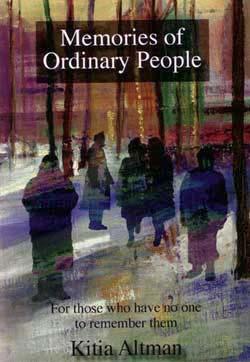
The fourth volume in the Memory Guide My Hand series centres on the Jewish experience in the former Soviet Union. As with all the other volumes, many of the tales are of survival in horrific circumstances. Tribute is paid to those who risked death by sheltering Jews or helping them actively to escape and find a new life elsewhere.
Julie Meadows introduced some of the Russian authors in the fourth volume of Memory Guide My Hand at the Melbourne Writersí Festival in September.
LITERATURE AND THE HOLOCAUST
Over the last few weeks I have been reading Les Carlyonís newly-published and massive history, The Great War. That may seem an obscure way of introducing the subject of the Holocaust.
Today, there are no Australian survivors of the First World War. The last of them died several years ago. This meant that Carlyon, a former editor of The Age and a colleague of mine on the newspaper, had no living survivors of the war whom he could interview.
He had to rely on the accounts of the day by war correspondents, or on the diaries of the generals, and on the tender and touching letters written home by the combatants, up to their necks in mud and rotting corpses, and living with the daily prospect of being blown out of existence by the German artillery.
Carlyon, in short, was writing history at one remove. Being the conscientious journalist that he is, he tramped through the fields of Flanders and northern France, sizing up the terrain (as he had done in his earlier book on the Gallipoli campaign) and doing his best to evoke the feel of the place then and now.
At this point, comparison with life under the Nazis breaks down. For the physical evidence of their bestiality has largely been destroyed. Remnants of the extermination camps still exist, but little else.
HOLOCAUST LITERATURE
But what we do have is a vast body of literature about the Holocaust. The stream of books, articles, films and television ìspecialsî is endless; no week is
complete without its share of memoirs and commentaries.
Much of this literary material is first-hand. Some of it, like Elie Wieselís Night, has assumed the status of a modern classic. No-one can read his account of a childhood spent in the death-camps of Auschwitz and Buchenwald without being moved to the core.
Among the scores of films ñ many of them fictional, with a cast of Allied goodies and German baddies - one stands out. Most of you will have seen it ñ Steven Spielbergís Schindlerís List: an adaptation of Thomas Keneallyís prize-winning novel, Schindlerís Ark.
The Schindler of the title was the flamboyant Austrian industrialist, Oskar Schindler, who daily risked his life to protect hundreds of Jews working for him in his factories in Cracow. Keneally, who hails from Sydney, had met one of Schindlerís survivors by accident in Los Angeles, and drew on his experiences and those of others saved from death by this improbable angel of mercy, to create and absorbing novel.
Spielberg turned it into an equally absorbing Oscar award-winning film. Side by side with this flood of books and articles on the Holocaust, there are the thousands of testimonies collected and deposited in Holocaust centres and museums (including this one in Melbourne).
The testimonies have been volunteered by people who are living witnesses to the horror story that is the Holocaust. As such, they form a persuasive argument rebutting the deniers and sceptics who insist the Holocaust did not happen.
12
Close to home, there is also the Makor Jewish Library in Caulfield. The venture, run by former teacher Julie Meadows, has published upwards of 70 books under the Makor imprint. All are by migrants, who were encouraged to write their personal stories. Most were Holocaust survivors, or children of survivors (see accompanying story).
Initially, the aim was to encourage the writers to tell their stories, and to have them published, as a gift to their children and grandchildren.
ìI told them to write while the events were still fresh in their mindsî, Julie Meadows says. ìIt did not start off as a Holocaust exercise. But when I put an advertisement in the Jewish News, seven of the first 10 applicants were Holocaust survivors. When I saw the first stories, they were so good I thought they should be archived. So I found people to work with me and set up the publishing program. What we have now is an archive that helps to define a generationî.
But as with the testimonies program, the Makor program will eventually come to a natural end,î Mrs. Meadows says. ìTime is running out for these people, because many of them are now in their eighties. Soon very few people will be alive who survived the Holocaustî.
HAS ALL BEEN SAID
This prompts the question: has everything been said about the Holocaust that needs to be said? Has the subject lost its novelty, and how long can it continue? Is it overdone? And is it destined to become just another sad and terrible chapter in mankindís warring history?
This prompts another question. Since the end of World War 11, the world has seen outbreaks of
genocidal madness in Rwanda and Cambodia, and on a smaller scale in Bosnia. Should Holocaust studies in schools and colleges incorporate such comparative material? Or should the Jewish Holocaust continue to be taught and viewed as something unique in itself?
This is a tricky question. My own private view ñ and it is not one that everyone will share ñ is that removing the emphasis on the European Holocaust and the systematic attempt to destroy the Jewish population and impose a Final Solution would be a serious mistake. It would blur the uniqueness of those events. It would devalue the currency. Genocide would become a sloppy term for any outbreak of violence anywhere in the world.
But that is another question. To the earlier onewill the subject of the Holocaust lose its immediacy and its interest when the last of the original survivors have passed on ñ I have only this to say. When the last of the Gallipoli Diggers died, there were those who said that interest in Gallipoli would quickly fade.
Instead, the number of Australians ñ particularly young Australians ñ who make the annual pilgrimage to the Gallipoli battlefields and the Dawn Service on the shores of Anzac Cove, or participate in Anzac Day ceremonies at home, has grown exponentially. A new awareness exists. Far from being forgotten, Gallipoli has assumed mythic status.
This could happen with the Holocaust as a younger generation listens and learns, and follows the trail left by their elders. They are starting to do so now.
Leonard Radic is a Melbourne writer, playwright and journalist. His play ìWitnessî, based on interviews with survivors, was read at the Holocaust Centre.
13 Donít miss the chance to become a ëPartner in Remembranceí through the Jewish Holocaust Centre Foundation. Join with Steven Spielberg, one of the Foundationís Patrons, and ensure the on-going success of the JHC. Three levels are available and are payable over five years. All donations are fully tax deductible Gold Partner $18,000 Silver Partner $10,000 Bronze Partner $ 5,000 Each ëPartner in Remembranceí will be acknowledged. Further details available from Helen Mahemoff, Chair of the Foundation 9822 8080 or 0417 323 595
PRIVILEGES WE MUST NEVER SQUANDER
Review: Paul Valent
The Diary of Petr Ginz, Edited by Chava Pressburger,
Foreward by Jonathan Safran Foer, Sydney Picador. 2007 pp 155 plus drawings.
prohibitions on reading newspapers, attending hairdressers, having laundry washed by Aryans. Petr notes systematic looting: having to hand in jewellery, fur coats, skis, radios, furniture, clothes, until Jews were allowed to own only one set of underwear. All this accompanied by increasing numbers of summons and deportations.
How did Petr respond? Like Anne, he lived his life as normally as he could. In a sense it is chilling that everyday events - the weather, school (exams, performances, being class captain and editing a journal), meetings with friends, winning or losing at marbles, birthday presents, books, madcap experiments, figured more in Petrís writing than the external events.
Some diaries and manuscripts have been unearthed recently that relate concerns of ordinary people during the advent of Nazism.
The latest manuscript is The Diary of Petr Ginz of a 12 year old Jewish boy in Prague, who for two years recorded his life before he was deported to Theresienstadt in 1942, and subsequently to Auschwitz where he perished.

Other books from the period are Defying Hitler: A Memoir by Sebastian Haffner (2002, London: Weidenfeld & Nicholson), and Suite FranÁaise by Irene NÈmirovsky (2006, London: Chatto & Windus).
The Diary of Petr Ginz has been described as the male (less effusive) equivalent of The Diary of Anne Frank. I will not compare the two diaries as literary works, which they were not meant to be. Both diaries are heart wrenching documents of gifted children from loving families, who are struggling to blossom while the external world wants to, and eventually does, destroy them.
Many child survivors of the Holocaust have told their no less poignant stories in recent books. The diaries of Peter Ginz and Anne Frank however talk from a perspective before awareness of the whole impending catastrophe, before innocence and trust were murdered along with their bodies. Their stories, miraculously and lovingly brought back to life, appear to speak from the grave, from a period when better times were being lost.
The childrenís diaries, through their individuality and intimacy, give a voice to, and a glimpse of, the magnitude of the tragedy, of a million and a half lives and hopes like Petrís and Anneís, having been violently extinguished.
CONTEMPORARY DOCUMENTS
Being contemporary documents, the childrenís diaries and the adult accounts provide an important legacy. Together, from different angles, they contribute, even if only a little, to the eternal question of how the Holocaust could have happened.
Petr records in his diary the sequence of laws and ordinances against the Jews: first, their registration; then forcing them to wear a star; then forced labour and loss of businesses; then ever increasing restrictions on attending public places and use of transport; curfews;
Though they impinged. Petr records with fascination that one of his teachers had been slapped by a German. Another time he records:
Fair weather all day.
In the afternoon I visited the Turnas, and I went to Troja [a suburb]. We were supposed to have a race, but it didnít happen, because some boy (age 14-15) throwing stones at us. On the way, Turna was stopped by a small, about eleven-year-old boy, telling him that he shouldnít talk to Jews.
He also said that he knows the law very well and that he would find out Turnaís name.
From Popper I got as two prizes for the boat race a small English textbook. In Troja I met my parents.
Occasionally Petr indicates insight into the situation:
Ö.In the morning I did my homework. Otherwise nothing special is happening. Actually, a lot is happening, but it is not even visible. What is quite ordinary now would certainly cause upset in normal times.
Petr does not record emotions, though one senses anger in his irony:
Hitler is fifty-three years old; there are flags and parades everywhereÖEvery building has to hang out a swastika flag, except for Jews, of course, who are not allowed this pleasure.
And in a poem self-castigation:
Ö.but every Jew lowers his sights
And follows all the rules heís got
And doesnít care one little jot.
THE SUMMONS
Jews obey the summons. Through intimidation and false hope, the Nazis ensure orderly departures. Those who stay help those who leave though both parties are anguished in their grief. One day Petr also boards the train.
We know from later preserved writings that in Theresienstadt Petr continued to concentrate on the immediate, to shut off his feelings, and hope that all would end well.
Remarkably, he continued to read, learn, paint (one of his paintings found its way to the Israeli astronaut on the ill fated Columbia mission), and maintain a spiritual life.
In the journal he edited he wrote:
14
Ö.A spiritual life? Could there exist anything more in those underground lairs than mere animal desire to satisfy physical needs? And still, it is possible!
Petr wrote inspiring stories to the end, sometimes quite distinct from his contemporary life. However, his last written record states:
The world is a rumpus, if you look at it objectively.
What about the adultsí writings? Irene NÈmirovsky was an acclaimed French writer who perished in Auschwitz at the age of 39. But before her deportation she wrote Suite FranÁaise, which posthumously, since 2004, is an international best seller.
NÈmirovsky describes how ordinary French men and women behaved in the face of imminent German occupation during their flight from Paris, and during the first year of occupation. She describes fear, panic, envy, greed, and dissects the various ways collaboration. She also describes generosity and sacrifice.
NÈmirovskyís sensitivity was lacking in one stark area- the persecution of the Jews. This event does not get a mention in Suite FranÁaise. Jonathan Weiss, in Irene NÈmirovsky; Her Life and Works, (2007; Stanford: Stanford University Press), believes that her ambivalence to her Jewishness, shown in her anti-Semitic portrayal of the hero in her pre-war success David Golder, and in publication of her articles in anti-Semitic magazines, had its roots in her unhappy childhood. However, her attitude might also have been an insurance policy against persecution, as were her conversion to Catholicism and securing a commendation from German soldiers for her hospitality. To the very end, she believed that, as in previous pogroms, connections, cooperation and reputation would secure her survival.
Sebastian Haffner was also a writer, as well as a fledgling 26 year old lawyer in 1933. In Defying Hitler; A Memoir he relates the events of that year in Germany. He completed the manuscript in 1939 in England, though again the book appeared only posthumously in 2002.
DEFYING HITLER
Similarly to NÈmirovsky, Haffner describes how fear, intimidation, envy, greed, and opportunism led ordinary Germans to withdraw
from, collaborate with, or participate in the Nazi regime. The only ways to defy Hitler were to mentally remember old values, or to physically escape.
The books give us coalface insights into the dynamics of fear and intimidation causing individuals and societies to view with dissociated fascination how a designated part of their population is singled out for persecution. Jews can also be such observers. Petr records his fascination at the looting of church bells and horses, and the removal of Czechs from their dwellings which were then repossessed by Germans.
There are other books from other catastrophes. For instance, Zlata Filipović in Zlataís Diary; A Childís Life in Sarajevo, (1994, London, Viking) describes in her diary, how during the siege of Sarajevo, through witnessing malice, destruction and the deaths of her friends, she was robbed of her childhood and innocence.

All these contemporary accounts contribute some insight into how the Holocaust and perhaps other genocides can happen. They occur through incremental steps of intimidation and terror, and acceptance of ordinances and unjust laws, especially when persecution is of another group; coupled with denial, and hope that obedience will save oneís skin.
The message of these books is that injustice must be nipped in the bud, and that human rights violations of other groups can eventually spread to oneís own. So when we turn away from the plights of other groups, such as when we do not object to injustice to aborigines or to refugee children who are given numbers in desert detention camps, we exhibit a dynamic that in some circumstances can take an ominous course.
A final comment: that adults and children were able to observe and describe intimate aspects of their senseless suffering is a testament to a devotion to truth and history, and a spiritual creativity that cannot be extinguished. That their books have been miraculously and lovingly retrieved recently in order to illuminate us, is a privilege that we must not squander.
Paul Valent is a renowned Melbourne psychiatrist and writer.
CONSIDER A BEQUEST TO THE CENTRE
Copies of a brochure explaining how to make a bequest to the Centre are available. After making provision for your families and other considerations, you may consider joining the increasing number of people who have, or are, considering providing small and large bequests in their wills to the Centre. This is a lasting acknowledgment of the Centre's work.
For further information call Elly Brooks, Bequest Officer at 9528 1985.
15
LAUNCH OF HOLOCAUST TESTIMONIES AT MONASH UNIVERSITY
Two thousand five hundred Australian survivor testimonies are among 52,000 testimonies recorded globally in the Shoah Foundation History Archive (IT) at Melbourne's Monash University. A living history of testimonies by victims of the Shoah for current and future generations, ensuring their stories will reveal the truth of what really happened in those horrific times. A tribute to all involved in getting the testimonies to Melbourne. An example if we will and work for it, it need not be just a dream. It will reveal what really happened under the Nazis and give the lie to the deniers.
While anyone can view the Australian video testimonies and photos (if they are available), and search for family names, towns, ghettos, camps and other many diverse experiences, there is also the possibility to search and request videos from the remaining testimonies recorded globally. Many are likely to be in foreign languages and require a minimum 48 hour waiting time.

It is expected that the Centre will provide trained people as support staff to the Monash library team, to assist viewers of the Archive. If you have basic skills, you can try the Archive for yourself by visiting the Clayton or Caulfield campus libraries. Or contact the Centre for training to assist at Monash.
Dr. Doug Greenberg, CEO of the Shoah Foundation Institute, launching the highly impressive Archives project at Monash (which honoured all the survivors who gave testimonies) gave an insight into Steven Spielberg's original mission in creating the Foundation, following production of the film ìSchindler's Listî, based on Tom Keneally's book ìSchindler's Arkî. Dr. Greenberg explained why the project took so many years in gathering the collection, digitization and the overall technology involved in the whole outstanding project, which will keep alive to message of and personal experiences of Holocaust survivors and the victims.
Dr. Greenberg outlined the work of the Foundation and the partnering in the USA, with the University of California and now with Monash, as the Australian custodian through the generosity of the Pratt Foundation and Lee Liberman.
The evening was hosted by Professor Edwina Cornish, Deputy Vice Chancellor and President of research at Monash.
A film "Messengers of Humanity", by Berry Liberman and Robyn Kershaw; a short video message from Steven Spielberg and other from Professor Max Nikias (Provost and Senior Vice President for Academic Affairs at USC) were shown. Professor Richard Larkins, Vice Chancellor and President, Monash University, also spoke.
STEVEN SPIELBERG'S SPECIAL VIDEO MESSAGE
Hollywood producer and Melbourne Holocaust Centre patron Steven Spielberg spoke by video to the large audience at the Monash Testimonies launch. He congratulated all involved, adding "Tonight is a special event. It began on a film set in Poland while working on Schindler's List.î He met so many people with a story to tell that the idea for the testimonies project began, germinated and has now passed 52,000 testimonies worldwide. "It is a tool for combating bigotry" Steven Spielberg added. "Racism and violence are the twin scourges. We, the living have a responsibility
never to forget, to remember. Zahor." He said we all had a unique opportunity to record the faces of the men and women whose faces could change the world. Steven Spielberg said he had never visited Melbourne, but hoped to do so and would "certainly visit the Melbourne Holocaust Centre." He thanked those in Melbourne and Sydney who had worked on the testimonies program. (Steven Spielberg is expected to be in Australia, including in Melbourne, later this year to film a TV miniseries, starring Tom hanks.)
16
DOUG GREENBERG AT HOLOCAUST CENTRE
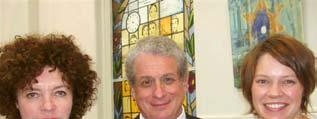
Earlier Dr. Greenberg lunched with members of the Holocaust Centre's volunteers and Executive (now Board), expressing delight at being among so many dedicated and committed men and women. He said the





Centre's work was renowned and made an international contribution to keeping alive the message of the Holocaust.
MALY KOHN DEVELOPMENT FUND

The JHC, together with the family of the late Maly Kohn, (past Volunteer Co-ordinator and Centre Guide), held a special tribute to commemorate Malyís extraordinary life and work at the Centre in May. The
Kohn-Weisz Families have established The Maly Kohn Professional Development Fund. Donations to this fund in Malyís memory would be greatly appreciated.
CAPACITY HOUSES HEAR BESTSELLING AUTHORS



Authors Daniel Mendelsohn and John Boyne gave memorable insights into their latest bestselling books, translated into many languages and soon to be made into movies, at the Centre in May and June.
The sessions were arranged in conjunction with the Sunflower Bookshop, and the Sydney Writers' festival. Many copies of the books were sold and there was a wide array of questions, including, about Boyne describing his work as a fable.

Daniel Mendelsohn, renowned American Jewish author and contributor to many journals, including the famous New York Review, spoke about his book "LOST" (published by Random House). It examines his search, in 12 countries, including Australia, to uncover what happened to 6 members of his family murdered in Bolechlow, Ukraine, in the Holocaust. He ties together biblical stories, insights into classical writings and autobiography to discover answers to his relativesí stories and lives.
He was in such demand that an extra session was arranged. Journalist Ben Naparstek interviewed the author. Associate Professor Mark Baker joined Mendelsohn in his first discussion.
Irish writer, John Boyne, who was extensively interviewed by email in the last issue of Centre News, spoke to school students and adults. He said he hoped his book, published by (Harper Collins), which has caused much discussion and even controversy, might open a door just a little crack and leave youngsters feeling unsettled and disturbed and want to learn more
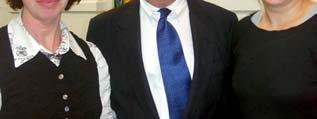
about the Holocaust.

The story tells of a nine-year-old German boy (son of a death camp commandment) who befriends a nineyear-old Jewish child through a concentration camp fence. Some readers, including Holocaust survivors, have described the manuscript as not suitable or realistic, especially as an insight into the Holocaust for young people.
A literary agent for children's books reported that it was not appropriate and warned Boyne's agent not to let his own child read it.
"I wanted it to work on several different levels, "Boyne added. "I wanted it to open a door for further investigation of the Holocaust. I have been a serious reader of the Holocaust for 10 years, fiction and non fiction. I wanted to keep alive the memory of those who died."

He hoped younger readers would have parents or teachers nearby to discuss some of the upsetting aspects of the story, questions that a novel of this type raises.
"I suppose I wanted youngsters to ask questions," he
17
Shmuel Rosenkranz, Doug Greenberg, Pauline Rockman, Abe Goldberg and Allen Brostek.
Ursula Flicker and Doug Greenberg.
Eva Scheinberg, Doug Greenberg and Julie Fenwick.
added.
He asked "Why did I choose this story? Sometimes the story chooses you."
He wrote the book's first draft in two days. It has become a world-wide success which has been eagerly bought by youngsters, teenagers and adults. In fact, it has two different front covers.
Boyne said he did not want to write a novel about camps, but chose one camp.
There were numerous questions, including from students, delving into all aspects of writing and especially about any fable aspects of the book. How could the Holocaust be told about in such a fashion? (This was one of he questions discussed by the author in Centre News last issue.)
DANIEL MENDELSOHN'S JOURNEY



Daniel Mendelsohn's talk held the audience in rapt attention, with his witty, enlightening and revealing address, including his Yiddish words scattered throughout.
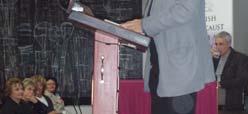
He said the book was not about him but about the missing members of his family. It drew on numerous aspects of Jewish life.

"It is about younger people asking older people questions, "he explained. "I have spent my life asking questions."

He was born and grew up in a heavily populated Jewish section of New York.




"Between 1890 and 1920, 30 million people came to the US. They are part of my family - part of my family story. It is like circles spreading out in a pool after a stone has been thrown in" he added.

The book started as a magazine article. After it came out, he found out about 12 relevant people alive,


and set out to talk to them, including in Australia. The first place he visited was Sydney, where five survivors told him about their lives, their very individual stories in the Holocaust. It was an enlightening meeting.
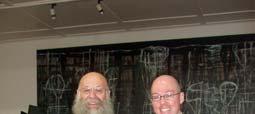
ìThe book is not just a memoir, not just about me. I don't claim to be an authority on the Holocaust, a Holocaust historian," he said.
"My book is about the prospect of retrieval. My family is interesting to me. I grew up with a grandfather who spun a tale about the shtetl in which he was raised.î
"Everyone I talked to had a different memory. I just wanted to learn what happened."
He added it was quite complicated to try and learn the truth - the real story.

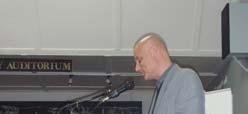
"This book is a kind of memorial, a monument, to a whole generation," he explained. "It is about the past and through words and pictures, it is about what I grew up with."
He explained that he wanted to record faces as well as words, how they described events. He used direct conversations in the book. Photos and their placement in the book were an important aspect of what he wanted to convey - their very special role in the work.
He also used biblical stories about Cain and Abel and Noah's Ark, so his story would be connected through analogies in some way to a pasha.
"Mine is an oral way of telling the story. That's the voice of my grandfather, who was born in 1902, in my head," he said.
The Centre's joining with Sunflower Books and publishers led to highly successful events. Audience comments, including from youngsters, were positive. They surely opened new doors, new insights and desires to follow up by all ages what they heard.
18
Left: Daniel Mendelsohn and Mark Baker. Middle: Daniel Mendelsohn. Right: Bernard Korbman and John Boyne.
Left: Jacob Rosenberg (whose latest book was released in September) with Daniel Mendelsohn. Right: John Boyne signing books.
CURATORIAL
Jayne Josem
At present the focus of the curatorial department is upgrading the permanent museum display. I am working on museum content with Bill Anderson and Elaine Davidoff from the Centreís Education Department, drafting, rewriting and finalising the text for each panel.
Dr. Julie Fenwick, Kathy Janovic and Hannah Miska are researching material from the archives for display. The newly-installed display on Irma Hanner in Terezin has resulted from this research. New volunteer Anna Ola is looking into making greater use of our Holocaust Art collection.
Special mention must be made of Eva Marks, who has been an excellent contributor over a long period. The Centre is grateful for her dedication and commitment. Her efforts in the Curatorís department are many and varied ñ and she is very handy with a hammer.
Some of the newer members of the team have written about how they came to the Centre and their work here.
Dr Julie Fenwick
I became interested in studying the Holocaust after participating in a school trip to Dachau and Yad Vashem Martyrsí and Heroes Remembrance Authority in Jerusalem, this made quite an impression on me.
As a university student, I revisited Yad Vashem for the winter school for educators. Returning to Australia, I enrolled in units on Aboriginal history and racism as I was interested in continuing to learn about issues of race. I started a doctorate which examined the ways in which Aboriginal
people conceptualised sovereignty. During my candidature I worked as a sessional Holocaust tutor at Monash and also completed a number of small projects at the Jewish Holocaust Centre.
Having finished my doctorate in July 2006, I was employed by the Jewish Holocaust Centre to work on a project funded by the National Library of Australia. The project examined a collection of Jewish stars and identification documents, as well as some textiles.
I recently received a special grant from the Friends of the Jewish Holocaust Centre to continue this study, which will focus on the collection of original items from the Lodz Ghetto, as well as material relating to Jews who fought against the Nazis in various armies and partisan groups.
Kathy Janovic
My interest in working at the Holocaust Centre stems from my background as the oldest of three daughters of Hungarian Holocaust survivors and my experience with the Adult March of the Living in 2004. Although it was a sad and deeply moving experience, it was also an empowering one, especially as a mother and grandmother.
I have a degree in Economics from Monash University, Clayton, and a graduate diploma in Evaluation from Melbourne University. I also have a diploma of Education from Monash and am very interested in the education programs at the Centre.

I am currently interviewing survivors, looking at testimonies and researching items for the museum upgrade. I am passionate about the role of the Centre today and its significance for the future. The important messages being disseminated through the museum displays, the survivor guide testimonies, and the education programs are critical.
ARCHIVES RECENT ACTIVITIES
Ursula Flicker & Claude Fromm
The Archives department continues with a dedicated team of workers to process the invaluable material that continues to flow into the Museum. The donors who provide this material are assured that their donations will be properly stored, recorded, and that future generations will have access.
As an example of how this material can be used, is the production of a teaching aid, utilising some of the many personal testimonies we are given. Titled "I showed them where my father was hidingî, eyewitness accounts of the Holocaust edited by our volunteer, Suzanne Fabian, the booklet has now been published and is available. More such teaching aids are planned for the future.
We get so excited when this rare material comes into our possession and would like to share the details of some recent acquisitions.
A whip (see photograph attached), from a Mr. Baxendale who's father got it from Bergen-Belsen



Concentration Camp on it's liberation in April 1945. It originally had five 'tails', somewhat longer than the two remaining ones, each of which it is believed were tipped with metal or something similar to make it more effective. The donor's father never spoke of his experiences at the camp or how he obtained the whip, but it survived several house changes and was eventually brought to Australia in 1993.
Another from another totally different sphere of
19
ROUND THE DEPARTMENTS
operation of Holocaust history, Russia, is a series of Anti-Nazi cartoons penned by Russian artists (see photograph of one these sketches attached).

Our department aims, and for this we need assistance from members of the Community, to collect, record and store more and all available material, and remember that even after it has been donated this material can always be accessed by any members of the donor's family.
Contact: Phone: +61 3 9528-1985 or archives@jhc.org.au
A RECORD FOR FUTURE GENERATIONS
Phillip Maisel
I am always conscious of the words of Herman Hesse in his work ëMadian,í ìEvery man is more than himself, he represents the special, the unique meeting point in which converges the world events once, just once, and never again. Therefore every story of every person is important, eternal and holy.î
Every life story told by Survivors is unique and of immense importance to all of humanity.
The events of the Holocaust were of such magnitude that they still remain incomprehensible to the world at large. Despite the mountain of documentation, including by academic historians, we would not be able to reconstruct an adequate picture of the events of the Holocaust without the personal voice of the survivors.
As Professor Geoffrey Hartmann, said in his talk at the Holocaust Centre in 1993, ìAll we would have had are the Nazi bureaucratic memos and orders of the day, orders and decrees, tons of Nazi jargonî, none of which would have conveyed the whole truth.
AIMS OF TESTIMONIES
I started to videotape testimonies for the Holocaust Centre 15 years ago. The initial aim was to document Holocaust survivorsí experiences, to challenge, with irrefutable evidence, the statements that the Holocaust never took place, and to leave a legacy for survivorsí descendants. But the ethos of individuals and the Centre changed to include the concept of understanding between peoples, and the potentially disastrous consequences of hate and intolerance.
I have assisted the renowned Shoah Foundation, in creating a similar project, which they have already concluded. I still receive many requests from people who wish to have their testimonies recorded. For them this is a release of pent-up traumatic memories, and giving testimony often has a therapeutic effect on them.
Copies of all testimonies are sent to Yad Vashem, Jerusalem, and to the Holocaust Memorial Museum in Washington. This serves a double purpose: copies of
the tapes are available in case of loss or damage to the original, and researchers have access to the records at these institutions. All VHS tapes have been transferred onto DVD format. For the last six years we have been recording testimonies on mini DV tapes and later they are converted to DVD or VHS format as required.
The work of the Centreís Testimonies Department is so varied that I can give you only a brief description of some of it. One of these is the Linkage Project with Deakin University which aims to analyse our testimonies from the points of view of history, society and language.
LIBRARY OF FILMS
We have a library of documentaries and films on themes related to the Holocaust. I also film major events at the Research Centre, such as the commemoration of the United Nations International Holocaust Memorial Day, a diversity of lectures by local and overseas identities and the memorial function to Maly Kohn. Maly made a significant contribution to the work of the Holocaust Centre for 20 years. We are attempting to put short excerpts from testimonies onto the Holocaust Centre website, and onto YouTube, subject to legal advice concerning copyright. In addition, volunteers are using special skills and expertise to interview survivors, to catalogue testimonies and to convert interview tapes to the required format.
Some volunteers transcribe them; one of them is producing a documentary film about the history of the Centre, based on videos of events which have taken place at the Centre from the beginning of its existence. We assist post-graduate students in their research in whatever way they require.
ìExplaining the Inexplicableî is our ultimate goal. Our task is to educate people about genocide in general in the hope that we can contribute to making the world a more civilized place. We have taken more than 1,340 testimonies to date.
Phillip Maisel is Head of the Centreís Testimonies Department.
20
ìSix million were wiped off the face of the earth. There is a danger that they will be annihilated from our memories. Are they doomed to a two-fold annihilation?î
Abraham Joshua Heschel
NEW DISPLAYS
Last year Dr Julie Fenwick completed a significance study of a selection of items from our collection. This 20,000 word report focused on a group of textiles and identity badges. In doing the study Julie unearthed vital new information about the provenance of some items. For example, what was once listed as a Jewish star now has a whole story attached to it about the person to whom it belonged. The study uncovered details about what happened to that person and their family during the war. Having this additional information enhances the display potential of items housed in our archives.
As a result of Julieís work we have recently installed a display on Terezin in the ghetto section of the museum, looking in particular at Irma Hannerís experience. Irma donated a very interesting range of material to the Centre, which includes her Jewish star from Dresden and mica from her forced labour in Terezin. Her collection also includes Jewish New year cards she made while in Terezin and books of poetry written by the girls she befriended in the camp. This display is designed to enlighten visitors about one Holocaust site and one personís experience of the Holocaust. It will be particularly interesting for students to see how a teenager endured the war.
A new set of artworks is on display in the Upstairs Auditorium. As part of the ongoing research into our Art Collection, different works are rotated into the display. They are not being displayed on the basis of
artistic merit but their ability to communicate aspects of the Holocaust experience.
The first artist on display is Malka Krystal. In addition to her artworks the museum possesses a manuscript by Malka called ìI am not a Germanî. In her story Malka reveals that she spent most of the war in hiding (although her paintings focus on life in the ghettos and camps). First she hid in forests near her town of Wislica, Poland, spending some of the time with partisans. Then she spent two years in a bunker with other Jews, where they were.
Following liberation Malka learnt that only 28 Jews from a community of 2,500 had survived the war. After the Russians liberated Wislica Malka had befriended some Jewish soldiers. One of them asked her if she would like to take revenge on the Germans. ìYesî she immediately replied and accompanied him to a field crowded with German soldiers. The officer handed her his pistol and invited her to shoot as many as she likes. This is how Malka ends her manuscript:
ëI looked around and saw the faces of young boys 16 or 18 years old. Holding the gun in my hand, I said to the officer: ëI could not shoot unarmed young kids.í
ëYour father and mother were unarmed, and they were shot by such kids,í the officer shouted. ëShoot them!í he screamed.
ëI am not a German,í I replied.
VILNA TODAY AND THE HOLOCAUST
Sue Hampel and Jewish Community of Vilna
Vilna, in Lithuanian Vilnius, in Polish Wilno, in Russian Vilna, in Yiddish Vilne, capital city of Lithuania. From 1323 capital of the Grand Duchy of Lithuania, between the two World Wars, a district town in Poland, then capital of the Lithuanian U.S.S.R. from 1940 until 1991. Called by East European Jewry, especially in the modern period, the ìJerusalem of Lithuaniaî (Yerushalayim de-Lita).
Poland.
Before the War, Vilnius was acclaimed for its Talmudic scholars, numerous synagogues and its thriving Yiddish language theatres, libraries and schools. Today there are only plaques that serve as reminders of the rich Jewish cultural life that once was and no longer is.
Our tour began in 19th century Jewish Vilna. Led by fifth generation Lithuanian guide, Daniel Gurevich of Jerulita Tours, we explored the cobble stoned streets and alley ways of this charming Old Town, looking for the cultural remnants of the city that the Vilna Gaon proudly called the ìJerusalem of Lithuaniaî. We found Zydu (Jewish) Street and Gaon Street in the former Jewish Quarter. The unavoidable fact is that there are only about 4,000 Jews living here out of the approximately 80,000 pre War population.
Sue Hampel writes: A visit to Lithuania is a must for those interested in Jewish History. I took the opportunity to visit this country with photographer Emmanuel Santos and videographer Sean Meltzer, before meeting the March of the Living Australia group in
Nazi brutality, aided by 10,000 Lithuanian collaborators, succeeded in murdering over 90% of Lithuaniaís 240,000 Jews. There are 220 killing fields in Lithuania. Most of Vilnaís Jews were massacred in Paneirai Forest, just 10 kilometres from the city centre. In seven large pits, the Jews of Vilna were shot and their corpses covered with dirt. Later, these bodies were exhumed and burnt as the Nazis destroyed all evidence of their crimes. Two memorials soberly remind the visitor of the terror inflicted on the victims.
Just 40 minutes drive from Vilnius lies the charming village of Ziezmariai. Here we discovered one of five
21
Sue Hampel in front of wooden synagogue in Ziezmaria, 30 mins drive from Vilnius, one of five wooden shules left in Lithuania.
remaining wooden synagogues in Lithuania. This remarkable structure was built in the 1880s and it survived the War as the Nazis used it to house Jewish slave labourers. The congregants of Ziezmariai are no more, they lie amongst the 2,200 victims buried in the nearby Kasiadoriu Forest.
We walked deep into the Kasiadoriu Forest as the snow flakes covered our tears. The trees stood as silent sentinels guarding the souls of those who perished here. A deep blanket of snow covered the large memorial that serves as a poignant reminder of manís inhumanity to man.

exiled in 1941 to the Soviet interior and many were confined in camps there.
On June 24, 1941, the Germans entered Vilna and were welcomed by the Lithuanian population with flowers and cheers. Persecution of Vilnaís Jewish population (approximately 80,000) began immediately. Prior to the establishment of the ghetto, about 35,000 Jews were murdered in Ponary. In January 1942 the various political organizations in the ghetto created a unified fighting organization, F.P.O. (Fareynigle Partizaner Organizatsye), commanded by Yitzchak Wittenberg, Joseph Glazman, and Abba Kovner.
In the beginning, the F.P.O. decided to fight in the ghetto rather than escape to join the partisans in the forests. In addition to smuggling in ammunition, the F.P.O. carried out acts of sabotage, issued an underground bulletin, and forged documents. On July 5, 1943, Wittenberg, the commander of the F.P.O., was arrested. While he was being led out of the ghetto, the F.P.O. attacked the guard and freed him.
There are so many places to visit in LithuaniaÖ the picturesque town of Trakai; Kaunus, the second largest city in Lithuania, once home to 40,000 Jews where Japanese diplomat Sempo Sugihara issued visas to over 6,000 Jews; the Ninth Fort where most of Kaunus Jewry were massacred in a killing spree.
We were warmly welcomed by Rabbi Krinski from Chabad and Rabbi Feffer from the Choral Synagogue who were delighted that Australians had come all the way from down under to visit the small Jewish community.
LITHUANIAíS PAST
With the outbreak of World War 2, Soviet Russia invaded Vilna and in October 1939 ceded it to Lithuania. Jewish refugees from divided Poland ñ the Germanoccupied part and the Soviet-occupied one ñ found refuge in Vilna.
In June 1940, Lithuania was annexed to the USSR. The Soviet authorities closed down Hebrew cultural institutions and Zionist organizations. All Yiddish press was replaced by the Communist partyís organ. Many Jews, active Zionists, Bundists, and ìBourgeoisî, were
Realizing that a price would have to be paid for this act of defiance, the underground ordered mobilization of all its units. The Germans issued an ultimatum for Wittenberg to surrender by morning or the ghetto would be wiped out. After hours of difficult deliberation, Wittenberg surrendered himself to the Germans and was murdered by the Gestapo. The F.P.O. then decided to evacuate to the forests.
On September 1, 1943, the Ghetto was sealed off. The F.P.O. was mobilized at once, and in the morning the German soldiers entered. Fighting erupted in several areas of the ghetto. Jacob Gens, Chief of the Jewish Police successfully petitioned the Germans to leave. Gens was the ghettoís most controversial figure. Some condemned him as an outright German collaborator, while others regarded him as a man who fulfilled German orders in an effort to save as many Jews as possible. Accused by the Gestapo of aiding the underground, he was shot on September 15, 1943.
During the first four days of September 1943, while 8,000 more Jews were deported to labor camps in Estonia, 200 fighters left the ghetto to join the partisans. On September 15, 1943, the ghetto was again surrounded, but the Germans withdrew when they learned that the remaining F.P.O. fighters were again mobilized for battle. On September 23 the Jews were ordered to prepare for the final deportation, which would liquidate the ghetto.
It is estimated that thousands and thousands of Jews from Vilna and the vicinity perished in the Vilna ghetto.

COME AND MEET AUTHOR THOMAS KENEALLY
Renowned author of more than 30 books, Thomas Keneally, will discuss his new book ìSearching for Schindlerî at the Holocaust Centre, on October 3, at 7.30pm.
Author of the award-winning book ìSchindlerís Arkî, made into a film by Steven Spielberg, Thomas Keneally, was listed many times for the internationally-famous British ìBooker Prizeî.
ìSearching for Schindlerî is Keneallyís story as a writer, from his early days, and about ìSchindlerís Arkî,
the people he met, the writing of the book, the filming and many unknown aspects of the work. The book led Keneally to think about Australiaís world position, the people he met in many lands including Israel, Germany, Austria and Poland, the Holocaust and how ìSchindlerís Arkî and the film altered his life.
ìSearching for Schindlerî gives an insight into the people he met, the actors in the film, the filming and many revealing aspects of the production.
22
Sue Hampel at Memorial in the snow covered Kaisiadoru forest. The Jews of Ziezmaria were murdered in mass graves here.
THE INTERNATIONAL TRACING SERVICE AND THE ARCHIVE CONTROVERSY
Lionel Sharpe
Towards the end of 2006 there was considerable excitement among Australian Holocaust survivors and some descendants, when the American CBS TV Channel presented an item on a '60 Minutes' program entitled, 'Revisiting the Horrors of the Holocaust'. Soon after its viewing I had a number of emails alerting me to the fact that a short film clip of this program was downloadable on the Internet. I did not hesitate to share their curiosity and immediately viewed the program.
The voice-over stated - 'For the first time, secrets of the Nazi Holocaust that have been hidden away for more than 60 years are finally being made available to the public. We're not talking about a missing filing cabinet - we're talking about thousands of filing cabinets, holding 50 million pages. It's Hitler's secret archive.' The voice went on to talk about '16 miles of shelves holding the stories of 17 million victims - not only Jews, but slave labourers, political prisoners and homosexuals'/

I recall an announcement by Associated Press in March 2006 that the eleven-nation body overseeing the International Tracing Service (ITS) archives in Bad Arolsen, Germany had set procedures in motion to open its records to the public towards the end of that year. At this stage four countries of the eleven had approved the plan, namely Israel, The Netherlands, Poland and the United States while three others, Germany, Britain and Luxembourg had indicated that they intended to give approval. However, Belgium, France, Greece and Italy were unclear of their intentions.
The head of the ITS, Reto Meister, had made a statement earlier that the core documents, which were being digitised, included incarceration records, death lists, camp registries and transportation lists. He estimated the ITS held 40 million documents involving 17.5 million people and all were housed in Arolsen, a small town about three hours journey by train and car from Hamburg.
The history of attempts to gain access to this valuable archive goes back many years. Jewish genealogists have long been at the forefront in advocacy for open access to the collection. Seven years ago, Dr Sallyann Amdur Sack, the editor of the prestigious genealogical journal, Avotaynu, was invited by the then director to visit the centre. Dr Sack, who visited Melbourne last year and spoke at a meeting at our Holocaust Museum and Research Centre, reported that the collection was located in a miniature Versailles-like palace spread over five buildings with a staff of 1,200 employees.
This collection, apart from the Yad Vashem Pages of Testimony, is one of the most valuable sources of information about the fate of people, Jewish and nonJewish, both victims and survivors, caught up in the Holocaust. The records are especially valuable as they place an individual at a specific place and time during the Holocaust period.
Up until the present the only way to access the information is to make an inquiry to the centre which will then search the collection and forward the results of their search. This usually takes up to one year. Furthermore, they refuse to process inquiries unless adequate information is given about an individual. As for the reliability of the information received, anyone who has had any experience researching archives knows the difference between doing it oneself and leaving the search in the hands of a clerk.
Perhaps the most articulate and persistent critic of the policy of the ITS is Peter LandÈ, a volunteer at the United States Holocaust Memorial Museum in Washington D.C. He has written numerous articles on Holocaust records and his research is well known among Jewish genealogists. In 2001 he wrote about some of the records which, in the early years after the war, became available to the United States National Archives.
'When United States troops entered Germany at the end of World War II, they seized all sorts of German records and brought them back to the United States. Among these were lists of Jews deported from Germany and extensive material from concentration camp records, primarily from camps located in the United States occupied zone of Germany, but also from other camps.
Before the original documents were sent back to Germany and given to the International Red Cross at Arolsen, microfilmed copies were made and given to the United States National Archives (NARA). These were held in NARA under the rubric "Captured German Records". Although this microfilm collection was available for public inspection, they were not included in NARA's official inventory/catalogue, and little use was made of the collection.
A few years ago, the United States Holocaust Memorial Museum (USHMM) purchased copies of these microfilms and this year a rough catalogue of the collection's contents was prepared. The sheer size of the collection, 189 reels of microfilm, i.e. approximately 189,000 frames or pages, made this task very difficult, but it is a beginning to understanding what this valuable
23
Holocaust Archives of ITS Bad Arolsen (Photo: AP/Michael Probst.)
collection contains.'
He went on to describe the content. 'A small part of the collection consists of deportation lists from various German cities. The completeness of this information varies by city: e.g., Berlin appears to be complete, Breslau and Frankfurt are not complete, while there are no records for East Prussia. The bulk of the collection, however, consists of concentration camp records, including dozens of arrival and "departure" (releases, transfers and deaths) lists. There are daily reports of changes, as well as some administrative material from the camps.
There are also some survivor lists. The coverage, camp by camp, varies widely, with large collections from Dachau and Buchenwald to very limited material on Gross Rosen. There are no camp records per se for such famous concentration camps as Auschwitz, Sachsenhausen, Stutthof (there is a separate collection for that camp) and Neuengamme, much less the "death camps" in Eastern Poland such as Sobibor. However, this does not mean that there is no information on camps not directly included in the collection. This is true since the Germans constantly transferred prisoners from camp to camp, so that there are many lists of transfers to and from Auschwitz, Sachsenhausen, Ravensbr¸ck and other camps, i.e., other than the death camps.
Legibility of the material is variable, from excellent to poor, but most material is legible. The extent of the information on individuals varies from a simple listing of family and personal name with prisoner number, to the same information plus date and place of birth, and, in a few instances, former residence and even the names of other family members.'
This description gives us some idea of the breadth and depth of what we will find in the future when all is accessible.
The March 2006 email newsletter of Avotaynu gave a scathing critique of the attitude of the German government over the years which claimed they wished to protect the privacy of Holocaust survivors by refusing public access.
It reported that Peter LandÈ, who attended this 2006 meeting of representatives of the eleven countries involved, said that Germany stood alone in continuing to block any action to open the records to the public.
It was reported that, 'the German representative
cited German archival law, which LandÈ noted is irrelevant, since ITS material is not subject to German law. European countries and the United States strongly objected to the German position. Although 10 of the 11 countries at the meeting favoured opening the records, nothing happened since the tradition is unanimity although the agreement itself does not provide for it, according to LandÈ'.
It is of interest to note that the former director, Charles Biedermann, was replaced in July 2006.
So where do we stand in mid 2007?
The most recent report informs us that two more countries, Luxembourg and Greece, have given their consent to public access and that only Italy and France have yet to give consent. In France, the process was delayed by the recent elections. However, the Avotaynu newsletter of July reports, 'that lack of approval by all eleven countries has not delayed ITS plans to make the records available to the member countries' - whatever this means!
The really good news is that the United States Holocaust Memorial Museum in Washington D.C. has received a $1 million gift from Norman and Irma Braman of Miami, Florida, designated to support the Museum's efforts to open and copy the International Tracing Service (ITS) archive and make it available to Holocaust survivors and scholars. With such gifts we will no doubt see an acceleration in digitising and less delays in gaining access to these records.
The value of public access to all Holocaust related documents was clearly demonstrated when Yad Vashem placed their millions of documents on the Internet a few years ago. This not only enabled people to seek information on lost family members but also made possible the uniting of family members who are descendants of deceased victims. The ITS records along with the Pages of Testimony will be a gold mine for those who are still trying to fill missing gaps in their family histories.
The website for the ITS is located at: http://its-arolsen.org/
Lionel Sharpe is Hon. Secretary, Australian Jewish Genealogical Society (Vic) & Honorary Research Associate, School of Historical Studies, Monash University
ANNUAL COUNCIL AWARDS TO VOLUNTEERS
Congratulations to all the recipients of the City of Glen Eira City Councilís Volunteer recognition awards, who join with many past awardees. The City of Glen Eira hosted the 2007 awards ceremony at Glen Eira Town Hall. Fifteen Centre volunteers received awards.
They were: Special Award: Maria Censor, Zyga Elton, George Ginzburg, Lusia Haberfeld, Stephanie
Heller, Maria Lewitt, David Prince, Pearl Recht, Sarah Saaroni and Fryda Schweitzer. 1000 Hours Award: Suzanne Fabian and Danka Schnall. 2000 Hours Award: Henri Korn and Rosa Krakowski.
The awards are made by the Council in recognition of the volunteer work by many people in the area.
If you would like details about sponsoring or advertising in an issue of Centre News, contact Debra Stiebel on 9528 1985.
24
A FORGOTTEN HERO
Saba Feniger
Among the lesser known of the numerous events of active resistance to the Nazis is the spontaneous and courageous action of Daniel Weiskopf M.D.
Dr. Weiskopf was well known as a doctor, both prewar and in the Lodz Ghetto. He was a man of a large stature and strength. ìHe had tried, unsuccessfully, to establish contact with the resistance on the ëAryaní side and had formed an underground group in the Lodz ghetto.î*
The image of this unsung hero looms large in my mind, begging to be told, considering the commemoration of the liquidation of Lodz Ghetto.
I have recently moved homes and had to scrutinise many papers. A letter to the Mayor of Lodz from my friend Dr. Salomea Kape, who lives in the United States, was among them.
She introduces herself as born, bread and educated in Lodz, where she received her medical degree in 1952. She briefly describes Hans Biebow who was executed in 1947 and other Nazis, who were responsible for the death of almost 200,000 Jews from Lodz and its vicinity, as well as from Germany, Luxembourg, Czechoslovakia and Austria.

This, she writes, is the introduction to the topic she wants the President to consider. With her permission, I translated parts of her letter written in Polish.
ìÖI am one of the 650 people whom the Germans left to ëclean up the ghettoí. We were to collect Jewish belongings left behind and send them onto Germany. We were quartered on Jakuba Street. Another 100 or so people joined us. These were Jews who were hidden in attics, cellars and other nooks during liquidation. The Germans used their well trained German Shepherds to find them.
In the end, there was a mass grave waiting for us all at the Jewish cemetery. Dr. Weiskopfís hiding place was discovered during these ëhuntsí for people. Biebow himself was directing this action and ordered Dr. Weiskopf to come out from his hiding place. Daniel appeared and the only weapon he possessed was a brick which he threw at Biebowís head. Biebow shot at him several times before he was killed but he managed to hear Daniel say: ëwar criminal, your days are numbered and you will pay with your life for the crimes committed on Lodzer Jews.í A few years later this prophecy was fulfilled.

ìThe heroic death of Daniel shocked our camp; he became our symbol of resistance, freedom and a model to emulate. His death is indelibly inscribed in my memory. Stories, I wrote about him, appeared in American periodicals and were later translated in the Lodz Tygiel Literacki. I include copies of the stories for they relate better the spirit of those times.
ìI hope it is not too late to ask you, the President of the City of Lodz, to protect the memory of Dr. Weiskopf from oblivion. I turn to you with a request that a street be named in his memory where the ghetto has been. We used to be one nation differed by religion. The history of Polandís Jews came to an end because they were liquidated by the believers in the
most horrific race theory that was later continued by another immoral ideology.
ìWe, Polish Jews carry in our hearts the vision of Polish cities, towns and villages where they will always stay. I, therefore, plead with you to pay homage to our Jewish-Polish heroes, because they belong to this soil, this Polish soil, where the streets of the Lodz Ghetto were permeated with blood. It is meaningless to honour them in strange lands.
ìI hope that my letter will strike a note in your heart, preferably a positive one.
ìI send greetings from far away New York and wish you and all inhabitants of my home town a good year 2000.
Dr. Salomea Kape
P.S. I enclose the names of eyewitnesses to the heroic death of Dr. Daniel Weiskopf who live in Poland.î
1. Dr. H. B., Lodz, (full name and address supplied)
2. Dr. H.P-L., Warsaw, (full name and address supplied)
Unfortunately, neither this letter nor one written to a previous President of Lodz had the desired effect, due to unrelated factors. While there are still some of us in whose memories Dr. Weiskopf has a prominent place, I submit this article to the Centre News so that many other readers would learn about his act of defiance. Itís worth noting that Dr. Weiskopf had a broken leg at the time.
* The Chronicle of the Lodz Ghetto.
25
****
Gravestone of Dr. Daniel Weiskopf.
Saba Feniger and Dr. Salomea Kape.
HOLOCAUST AND JEWISH-CHRISTIAN THEOLOGY
Under a grouping of four large-sized photos of the Nazis burning books, three well-known theologians discussed ìThe Impact of the Holocaust on Jewish and Christian Theologyî at the Holocaust Centre in late July.
discussions in the next issue.
Perhaps the evening was summed up by the end remarks of Cardinal Cassidy.
ìI see these theological developments and discussions as a response to the challenge that has come to us from the experience of the Holocaust. To conclude, I would quote the final words of the document We Remember: Refelection of the Shoah, issued by my Commission for Religious Relations with the Jews on March 16, 1998.
The ëvictimsí from their graves, and the survivors through the vivid testimony of what they have suffered, have become a loud voice calling the attention of all humanity. To remember this terrible experience is to become fully conscious of the salutary warning it entails: the spoiled seeds of anti-Judaism and anti-Semitism must never again be allowed to take root in the human heart.î
Written across the photos were the words of Heinrich Heine ìWhenever books are burned, men too are burned in the end.î It seemed to have a special meaning for the nightís program, attended by a capacity house.

Introduced by Alex Dafner, Holocaust VicePresident, the four speakers ranged far and wide in their comments, including briefly the question of Palestinians and Jews.
Speakers were Cardinal Idris Edward Cassidy (who headed a Commission of the Holy see for Religious Relations with Jews); Rabbi Fred Morgan (Senior Rabbi, Temple Beth Israel, Melbourne) and Tim Costello (Director, World Vision Australia).
They were thanked by Shmuel Rosenkranz, Immediate Past Co-President and President of the Holocaust Centre and now lifetime Past President. Centre News will carry full reports of the
Many questions were asked, including by a survivor who wanted to know where was God when millions died and he, the survivor saw the smoke rising from the chimneys. This question and many more including, did God die in Auschwitz or have our definitions of God changed since the Holocaust and do Christians view Jews differently in the post-Holocaust era and the position of Poland. Bernard Korbman, the Centreís Executive Director, in answer to a question about Poland, said he felt safer in Poland as a Jew than in France. There also was mention of the growing antiSemitism in England.
Members of the Board mingled with the speakers in a small gathering before the discussions began. In all, it provided much to ponder, especially in our uncertain world of today.
How much has it changed? Where does the Centreís mission to not only keep alive the message of the Holocaust but to combat racism, hatred and prejudice and foster understanding fit into the current global situation?
DONíT HIDE HOLOCAUST FROM CHILDREN
The following item from the School Library Journal seems pertinent to all who are wondering about relating to the Holocaust, and whether they should be, to youngsters.
Within the last few years, librarians have seen a proliferation of novels and memoirs dealing with the Holocaust published for young people. But along with the narratives and memoirs for older readers, a large group of supposedly simple illustrated books is being offered to a younger crowd. Consequently, one might conclude that children these days are prepared to absorb much of the horror of recent history at a tender age. However, parents, teachers and librarians need to use these books with sensitivity. Even a child who is an
excellent reader may not be ready to understand a bookís content or the graphic nature of some illustrations.
Adults are compelled to confront the subject of evil in our world and explain it to children in our care. We hope that children understand that we do this not to scare them, but to teach. The importance of this literature, besides the inherent history lesson, is that it can be used to convey values ñ the value of social justice and moral courage, problem solving and resisting prejudice. In light of recent world events, including a Holocaust denial conference held in December 2006, this literature has proven relevance. Cleary, the Holocaust should not be hidden from children.
26
TELL THE CHILDREN
The following is typical of the numerous letters we receive at the Centre, following visits by adults (local and overseas) and thousands of high school students.
I recently brought my 20 year old daughter to your museum. Having grown up with many Jewish family friends (some of them survivors from Holland) and having been well educated about the Holocaust over my life time as the daughter of a Dutch immigrant (nonJewish), I am surprised that I have taken so long to visit. Walking around with my daughter, through your touching exhibits and listening to the stories of survivors, Irma and Willie, gave us a very human and personal experience of this terrible time in our human history. My father once said to me ìtell the children, for
as long as children are taught about this part of history, the less likely it is to recurî ñ I agree. I think all schools should make time to visit you.
As a counsellor, I deal with many clients who experience grief and loss. I believe in the cathartic process of telling the story as an adult, thereby helping the wounded person within the person to achieve some healing. My experience of listening to Willie reinforced this view. Having listened to him, I again watched the movie ìSchindlerís Listî with different eyes this time. My daughter has done some reflecting and thinking beyond her requirements for social work study. Next time Iíll bring my son. Keep up the good work. Cathie
Nederveen
LETTER FROM GERMAN STUDENT
Dear employees of the Holocaust Museum in Melbourne, I took part in the school excursion to your museum, and I would like to thank you for the very interesting and insightful information you gave us. Your stories and fate are deeply shattering and disturbing, and I'd like to thank you for your willingness to share your stories with us.
Last year I went with my school to the Concentration Camp Theresienstadt, so it had a great impact on me to meet somebody in Melbourne who was imprisoned there for 3 years of his childhood, suffering
so much.
Special thanks to Sonia, who used to live not far from my home town Leipzig, in Dresden. Thanks also to Willy and George for their first-hand and really touching information.
And finally, I would like to express my respect for what you have achieved with the museum, for your attitude towards life, and for your impressive voluntary commitment to share your experiences as citizens of Jewish religion during the Third Reich.
Philipp K‰ks, Kitzen, Germany
To receive your on-line subscription you must register with the Centreís office Please ring or email the office on 9528 1985 or admin@jhc.org.au.
www.jhc.org.au
What one Christian does is his own responsibility, what one Jew does is thrown back at all Jews. Anne Frank, death camp victim (1929-1945)
27
CENTRE
the next issue in December, Centre News will be available
to download and
ó IN COLOUR DIRECTLY FROM
WEBSITE.
CENTRE NEWS IS GOING ON THE INTERNET!
NEWS IS GOING ON THE INTERNET! From
Online
print
OUR
MAKE A PLEDGE MAKE A PLEDGE
HAVE YOU CONSIDERED DONATING TO THE HOLOCAUST CENTRE?
PLEASE HELP US MAINTAIN THE CENTRE AND KEEP ALIVE THE HOLOCAUSTíS MESSAGE AND THE MEMORY OF ITS VICTIMS.
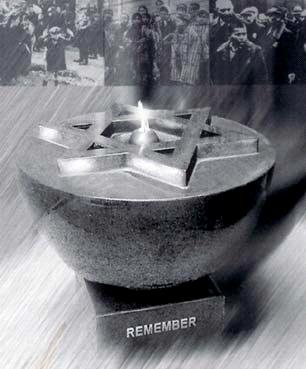

WE MUST KEEP THIS LEGACY ALIVE FOR THE FUTURE WE MUST KEEP THIS LEGACY ALIVE FOR THE FUTURE
I pledge the amount of $
Name
Address
Credit Card Bankcard Visa Mastercard Amex
Number
Expiry Date /
Please make cheques/credit card payments payable to: JEWISH HOLOCAUST CENTRE INC.
Credit Card Payments can be made by: Phone: 9528 1985 Fax: 9528 3758 OR Email: admin@jhc.org.au
ALL DONATIONS ARE TAX DEDUCTIBLE
15 Selwyn Street, Elsternwick VIC 3185
28
!
ACQUISITIONS: FEBRUARYóMAY 2007
Ursula Flicker
The following are the latest additions to our collection: Article titled ìJewish prisoners turned on Nazis in bloody revoltî published in Sydney Mirror newspaper edition No. 741 of 08/08/1969.
Donor: Mr. Miron Fisher
Photocopies of documentation concerning the work of Freda Laycock in San Bostel after the victory in 1945.
Donor: Mr. Ken Laycock
Book in Yiddish titled ì10th anniversary of Warsaw Ghettoî by Mark Berk published in Warsaw, Poland in 1953.
Donor: Mr. Leonid Shwartsman and Mr. Miron Fisher
Series of photographs of conditions found at Dachau Concentration Camp by the U.S. Armed Forces at time of liberation. Framed and glazed by Gaby Nozik and on display in Archives Department work room.
Donor: M/s Kathy Hotchin
Photocopy of certificate for medal ìCross for the participation in the battle for Leninoî.
Donor: Mr. Natan Hartenstein
Letters, photographs and postcards pertaining to the family in Warsaw during the occupation by the Germans, and other members of the family in Argentina.
Donor: Mrs. Emilia Blutstein
Book in Dutch titled "Anne Frank - Het Achterhuis (Anne Frank - The Diary)" The Diary 12 June 1942 - 1 August 1944 with introduction by Romein-Verschoor (M/s) Annie. Second edition printed in Amsterdam Holland in December 1947.
Donor: Mrs. Elly Von Der Wiel
DVD of photographs taken while on an overseas trip to Slovakia and Hungary of Jewish heritage sites and memorials together with the restitution file of parents of Peter Gaspar the estate of the late Imre and Jenny Gaspar.
Donor: Mr. Peter and Mrs. Lesley Gaspar
Original and copy of ìKetubahî between groom Mr Ignacy Rosshandler and bride Miss Rachel Goldberg who married on 14/04/1946 in the U.K.
Donor: Mr. Ignace Ross
3 original letters from prisoners in Auschwitz written to donor in Slovakia between 1942 and 1944 together with copy of extract from book re escape from Auschwitz.
Donor: Mr. Tibor Winter
Journal ìInterfaceî winter 2006 edition together with an article titled ìWords from the pastî and a letter in Polish written in 1943.
Donor: Mrs Lilka Barnea
Original documents from the Warsaw Ghetto comprising tram tickets, work and registration certificates especially designated for use by Jews.
Donor: Mrs. Halina Cukierman
Pages of hand-written diary written in the Polish language in two bound exercise books. Kept in Poland between the years of 1942 and 1944, by the late mother of donor, Cukierman, nee Zajfsztajn, (Mrs) Doba-Necha, the sole survivor of her large family, who was born in Lublin, Poland to middle- class Jewish parents.
Donor: Mrs. Esther Csaky The Centreís Archives asks more donors to bring their treasured documents, objects and artefacts to it for safekeeping.
Please help us in preserving the memory of yours and our loved ones who suffered and perished during the Holocaust by donating the items to the Archives Department.
29
PERSONAL ANNOUNCEMENTS
Birthdays
Maria Censor, Lily Dubs, Jack Debatyski, Julie Epstein, Amelia Giligich, Cesia Goldberg, Aaron Gurvich, Irene, Jeffrey Janke, Ashley Kras, Jeff Lipshutz, Rena Lipton, Phillip Maisel, Linda & Ivan Maldovan, Dora Oliver, Ken Opat, Sam Silver, Dr. Ruth Varon and Pinche Weiner.
Wedding Anniversaries
Sam & Leah
Inger & Kurt Friedlander
Rae & Mervyn Silverstein

Engagements
Mazel Tov to Stan and Eva Marks on the engagement of their granddaughter Caitlin to Ollie Kwang (London).
Get Well
Sean Rockman
Sue Fabian
Abram Kolski
Ruth Crane
Eva Somogyi
Weddings
Jeremy & Amanda Wrobel
Tamara & Wayne Laskie
Condolences
In memory of Abraham Helfenbaum
In memory husband Ale Gelerman
In memory of the late Bronia Knoche
In memory of Alec Strauss
In memory of Reise Wertheimer
ABRAM & CESIA GOLDBERGíS WEDDING ANNIVERSARY
Sixty years wed and still best friends. Thatís the grand achievement of Cesia and Abe. Their story was featured in The Ageís Good Weekender, ìThe Two of Usî pages and there was a morning tea at the Centre. We hear there were other celebrations, almost non-stop for a week.
Abe, one of the Centreís earliest volunteers, longtime treasurer and guide, and Cesia, were married in Belgium. Cesia has been running the Melbourne Kadimahís social lunch club every Wednesday for 23 years, with a different speaker each week.
Cesia says while Abe may be the head of the family, she is the neck. Mazel Tov to this wonderful twosome,
and the wish for many more anniversaries. After all, it takes two to tango.
JEWISH HOLOCAUST CENTRE COMING EVENTS
SUNDAY 21 OCTOBER AT 3.00PM
YOUNG FRIENDS
PLAYREADING OF ìNOTES FROM THE WARSAW GHETTOî BY NEIL COLE
VENUE: JEWISH HOLOCAUST CENTRE
WEDNESDAY 3 OCTOBER AT 7.30PM
WRITER, THOMAS KENEALLY DISCUSSES HIS NEW BOOK
ìSEARCHING FOR SCHINDLERî
ENTRY: $10/$7
VENUE: JEWISH HOLOCAUST CENTRE
SUNDAY 22ó24 OCTOBER
HOLOCAUST DOCUMENTARY FILM FESTIVAL
SPECIAL GUEST:
DOCUMENTARY FILMMAKER WILLY LINDWER (HOLLAND) SCREENINGS AND DISCUSSION
VENUE: TO BE CONFIRMED
Printedby:EllikonFinePrinters,Fitzroy,Victoria.Australia
30
Abe & Cesia Goldberg celebrating their wedding anniversary at the Centre with volunteers and staff.
Help support the activities of the Museum by becoming a Friend
Friends of the Jewish Holocaust Museum
Membership Application Form (2007ó2008)
Title ÖÖÖ.. First Name ÖÖÖÖÖÖÖÖÖ Surname ÖÖÖÖÖÖÖÖÖÖÖÖÖÖ
Address ÖÖÖÖÖÖÖÖÖÖÖÖÖÖÖÖÖÖÖÖÖÖÖÖÖÖÖÖÖÖÖÖÖÖ
Phone ÖÖÖÖÖÖÖÖÖÖÖÖ. Mobile ÖÖÖÖÖÖÖÖÖÖÖÖÖÖÖÖÖÖÖ
E-mail ÖÖÖÖÖÖÖÖÖÖÖÖÖÖÖÖÖÖÖÖÖÖÖÖÖÖÖÖÖÖÖÖÖÖÖ
FRIENDS ANNUAL MEMBERSHIP
" $25 Single " $45 Family " $15 Single Concession ÖÖÖÖÖ.
" Tick here for Young Friends (under 35)
ENTERTAINMENT BOOK $60 per book (plus $7 postage) ÖÖÖÖÖ.
RAFFLE BOOK $30 ÖÖÖÖÖ.
DONATION (All donations over $2 are tax deductible ÖÖÖÖÖ.
PAYMENT DETAILS
TOTAL AMOUNT $
" Cheque payable to: Friends of the Jewish Holocaust Museum Inc.
Credit Card: " Visa " Mastercard " Bankcard " Diners Club " American Express
Card No:
Expiry Date: /
Cardholder Name: Signature:
31
Please send payment to: Friends of the Jewish Holocaust Museum, 13-15 Selwyn Street, Elsternwick 3185 Telephone: 9528 1985 Fax: 9528 3758







32
www.kligerwood.com.au

ESTATE AGENTS, AUCTIONEERS, PROPERTY MANAGERS, VALUERS


DIRECTORS
Barry Novy & Eugene Wood
ASSOCIATE DIRECTORS

Nicholas Breheny & Rogan Sedger
Proud of our reputation for excellence in professional property services for 66 years.
33












34




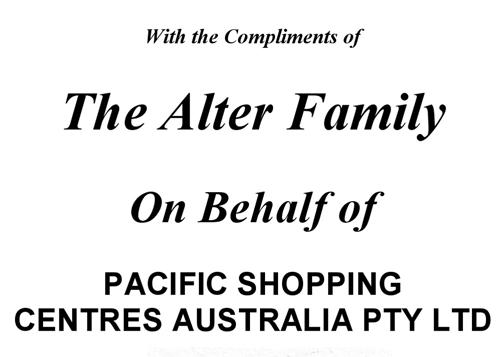
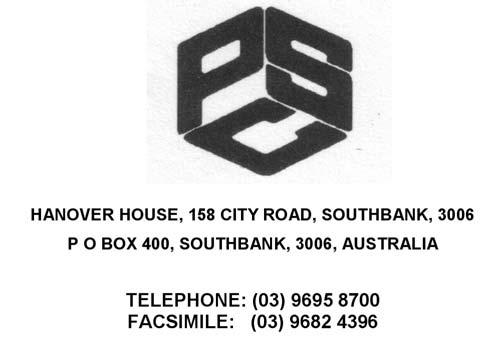


35
Organic produce, health food, cafÈ and natural therapy store.

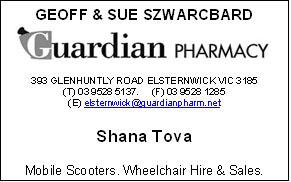

(Present this ad. for your free coffee or tea.)







36
358 Glenhuntly Rd, Elsternwick. VIC. 3185 Ph: 95237824



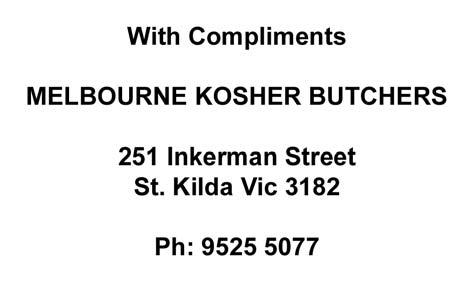

37 With the Compliments of Harry Blatt Pharmacy 781 Glenhuntly Road Caulfield South Ph. 9523 9695







































































































































































